If you’re a cooking hobbyist or baking enthusiast, you probably know that you can never have too many kitchen tools, gadgets, or accessories. Kitchen gadgets can make cooking more convenient through effortless preparation and food organization.
In this article, we’ll go over some 3D printable kitchen accessories you can use to make an assortment of different foods. For each design, we’ll go over what it does, how to print it, how popular it is, where to find it, and more!
Before we start, however, it’s important to go over food safety for 3D printed objects. Always keep food contact with 3D printed parts to a minimum, but if that’s not in the nature of the part, you can print food-contact objects in a food-safe filament. Even with a food-safe material, be careful that you thoroughly clean the part after each use, as you don’t want any trapped food particles!
And if your 3D printer is on a break, check out Craftcloud for manufacturers that may see to the requirements of the different prints (especially those that won’t be in contact with food). It’s as easy as uploading a design, picking the materials, selecting the manufacturer, and having the prints delivered to your doorstep.
Food Preparation
In this section, you’ll see some models meant for turning ingredients into a meal. From a sushi maker to a pasta press, these gadgets make food preparation a breeze.
Strainer Bowl
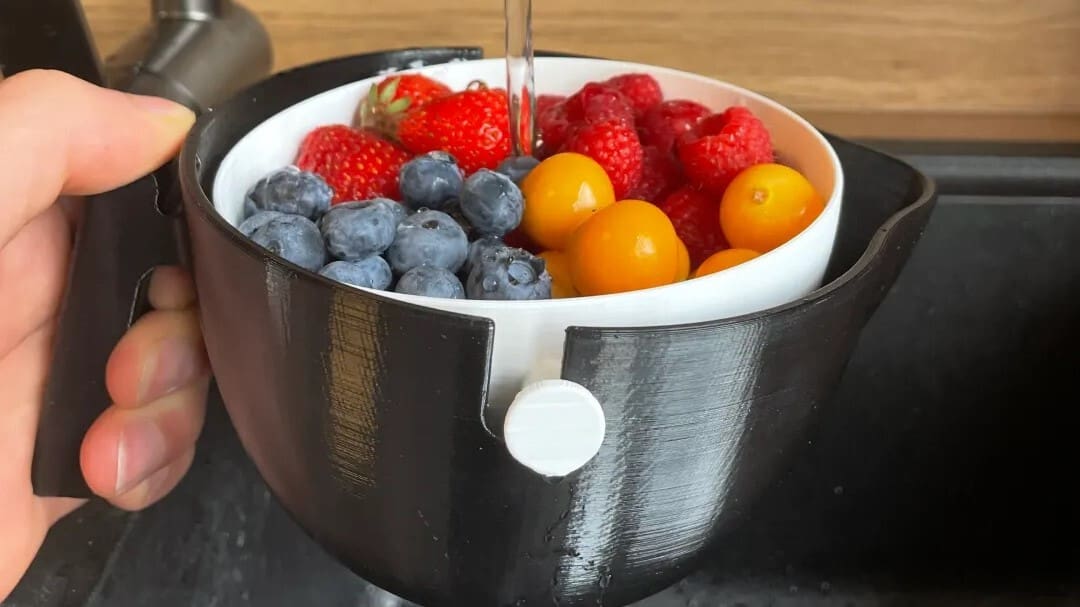
Whether it’s for a nice breakfast or just a snack with your favorite fruits, a good rinse is necessary to avoid contamination with dirt or pesticides. No matter how beautiful colorful fruits may seem at first glance, they can still be contaminated. This accessory is recommended for small things like raspberries, blueberries, and strawberries, but it can also be used with some smaller vegetables like cherry tomatoes.
You will need a printer with a print area of 200 mm x 200 mm, as the sieve is 8 cm high, 14 cm wide, and 18.4 cm long. The author recommends printing the sieve shell in PETG. Several users have praised in the comments the functionality and beauty of the model, while other comments report that they used stands for the sieve to make it even more useful.
- Who designed it? 3DPrinthusiast
- How popular/printable is it? This amazing bowl has more than 250 downloads and 4 makers have shared makes.
- Where to find it? Printables
Garlic Press
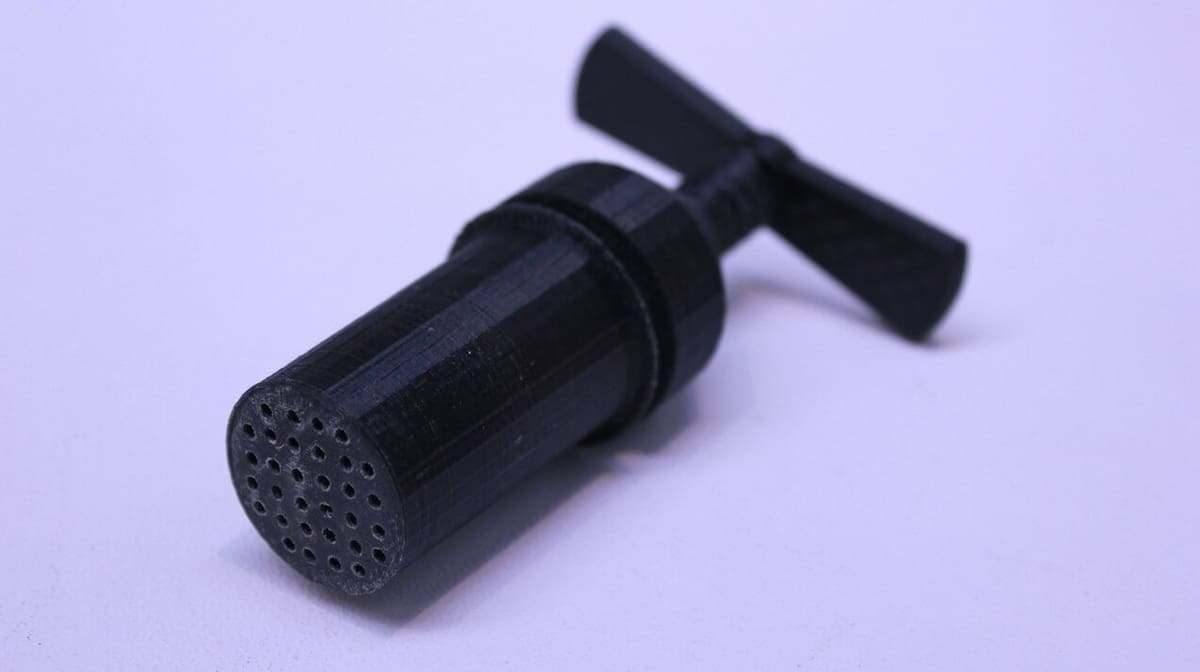
Garlic can be a key ingredient in many meals, but slicing it small enough is time-consuming (and risky for your fingers). This garlic press allows you to easily crush garlic to add to whatever you’re cooking. It’s made up of four 3D printable parts that screw and fit together.
The designer recommends printing the pieces with a 100% infill for strength. To complete the design, you’ll need to use a drill or rotary tool to make holes in the bottom of the extruding part. A 1/8″ bit (3.175 mm) is recommended, though you can also use a bigger or smaller drill bit according to your liking.
- Who designed it? daveseff
- How popular/printable is it? This garlic press has seven shared makes as well as a remix.
- Where to find it? Thingiverse
Butter Box
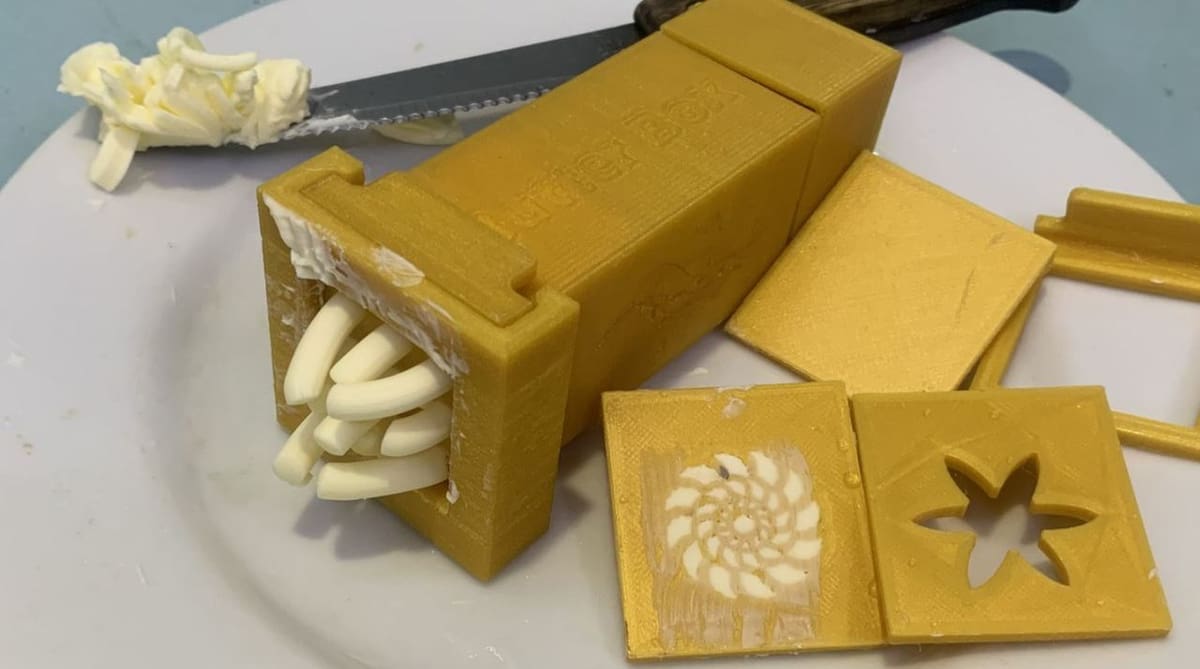
A butter box lets you easily extrude butter in a certain shape and size. This design includes a few different patterns for extruding the butter, including a star-like shape, concentric circles, and a curled 2D spiral. For this accessory, you’ll only need a few nuts and screws, which you can find the specifics of on the project page.
The designer states that they printed this butter box with a 25% infill and in PLA. The files are printed standing up, so you won’t need supports.
- Who designed it? Henry Wang
- How popular/printable is it? This design has over 4,700 views and 440 downloads.
- Where to find it? MyMiniFactory
Spaghetti Gauge
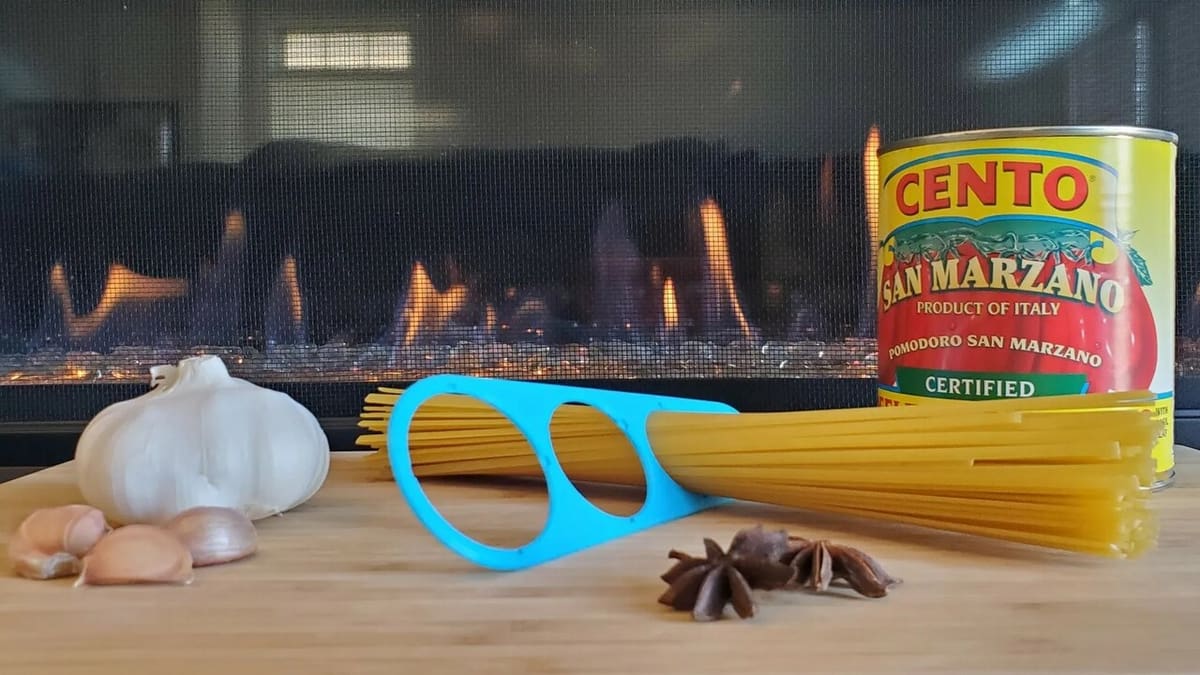
This is a simple tool for measuring the serving size of your spaghetti (or any long pasta), with portions ranging from a single serving to a serving for four.
The gauge design is quite straightforward, so you can easily store this in your kitchen drawers or hang it on a hook. If you find that the portion size is too small for your appetite, simply scale it up a bit and enjoy the right amount of pasta for your meal!
- Who designed it? DesignItThen
- How popular/printable is it? This measuring tool has 26 posted makes.
- Where to find it? Printables
Pasta Press
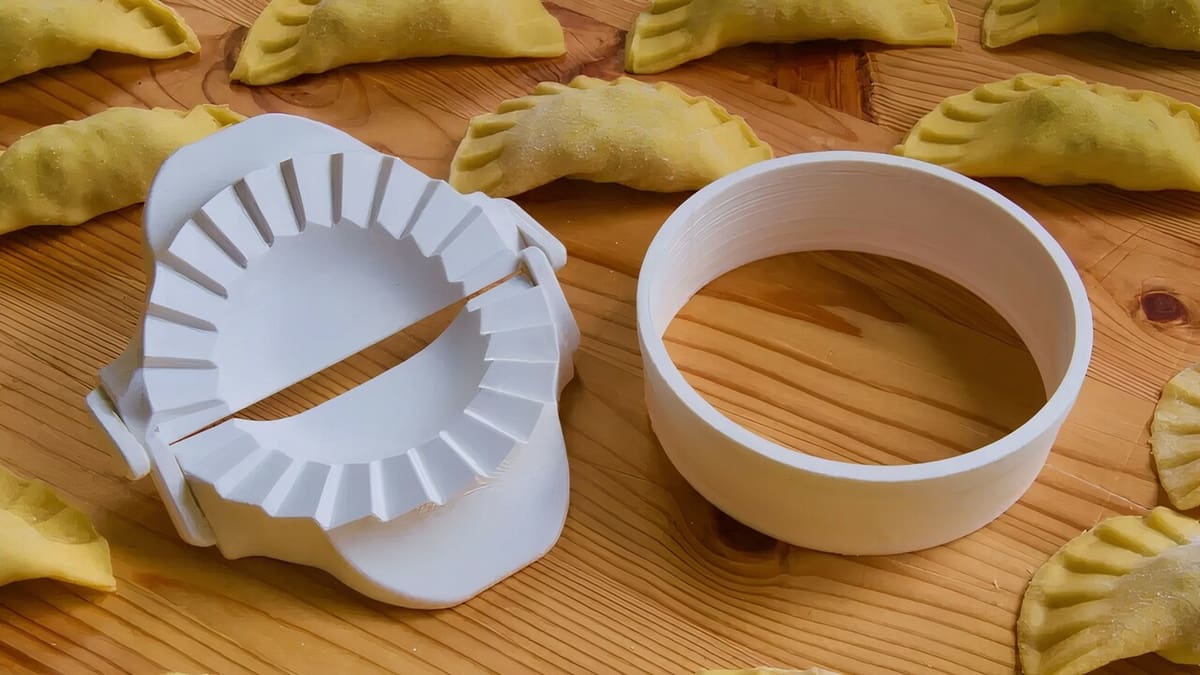
Are you bored with plain old spaghetti? With this gadget, you can enjoy stuffed pasta similar to a mezzelune, for which all you will need are your pasta sheets and the filling. The gadget includes a pasta press and a cutter that create the perfect pockets of pasta. And if you’re craving empanadas, like this maker, you can just scale up the model.
One minor thing to note is that putting together the hinges of the pasta press might take some effort, but it’s advisable to print them completely solid so that they don’t snap while being used.
- Who designed it? mmOne
- How popular/printable is it? 46 makers have shared their pasta press prints.
- Where to find it? Printables
Fish Scales Cleaner
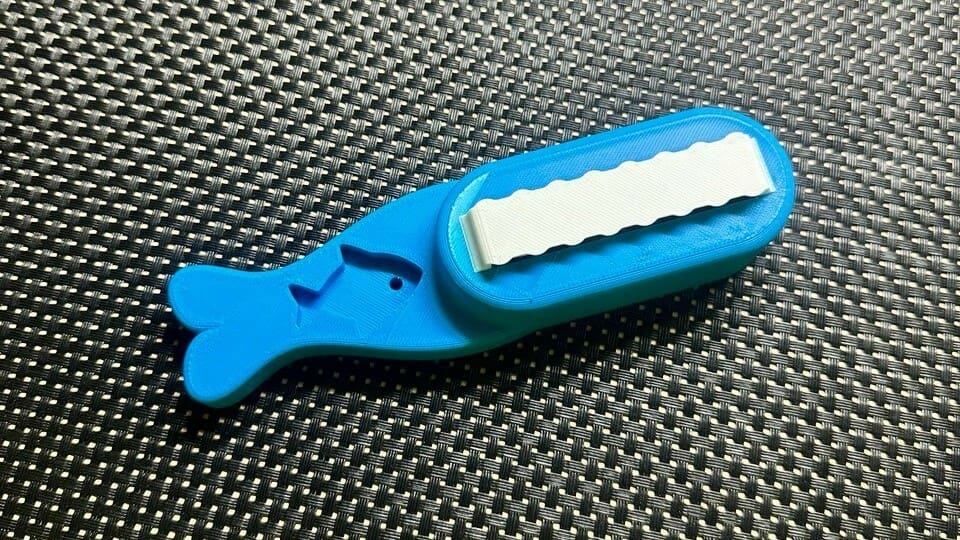
Cleaning fish scales is always laborious, and sometimes a knife is used, which can result in cuts. Having a safe, easy-to-use, and easy-to-clean option can be a great idea and doesn’t cost much material.
This scaler has two sides, which helps make the task even more practical. There is also a small compartment where the scales can be accumulated for ease of cleanup.
The author recommends a layer height of 0.16 mm, a brim for better adhesion, and emphasizes the need to make the parts with 100% infill so that it’s robust enough to withstand higher force and prevent breakage. Perhaps even the little ones can help prepare a beautiful meal or work on the catch of the day.
- Who designed it? impietro
- How popular/printable is it? This practical tool has 27 makes and 54 downloads so far.
- Where to find it? MakerWorld
Sushi Maker
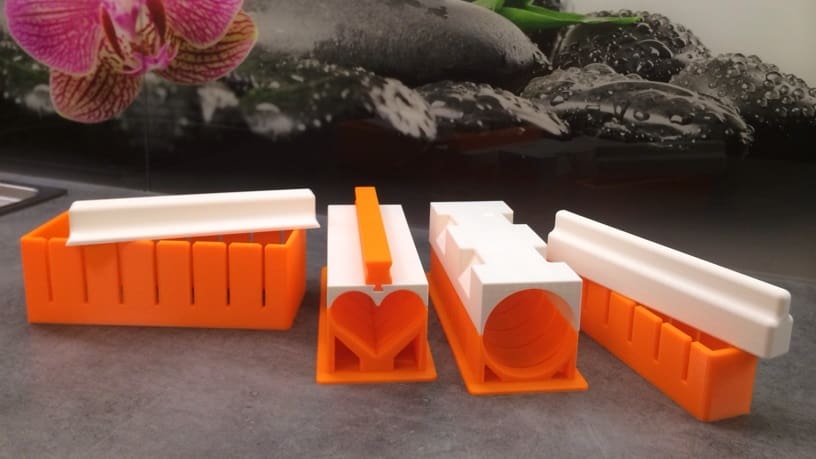
Sushi can be hard to arrange neatly with your bare hands, especially if you’re aiming for a specific design or shape with the filling. This sushi maker assists you in this process by providing a mold-like structure with holes for cutting the sushi into bite-size pieces. You can also choose to have the multi-part system with a specifically-shaped mold like a heart, circle, or rectangle.
As the creator of this design states, printing should be pretty straightforward and work with any preferred layer height. The designer recommends printing the model with a heated bed, most likely to prevent warping. They also added that you should consider printing the test model, which will allow you to check that the parts fit together.
- Who designed it? Meh4d
- How popular/printable is it? This sushi maker model has 19 makes as well as a couple of remixes! You should definitely be able to make this model like so many people have been able to do before!
- Where to find it? Thingiverse
Egg Cracker
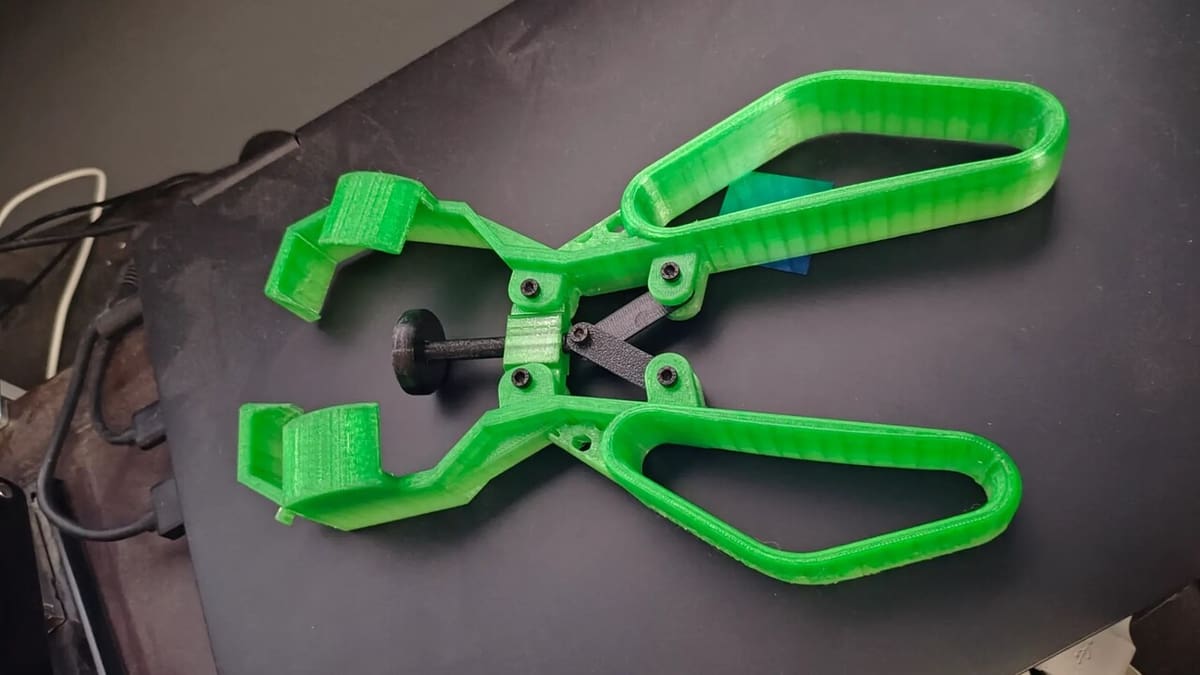
Cracking an egg with your hands can be a messy affair, especially if there are quite a few to get through. This kitchen gadget helps you crack eggs with little effort and keeps your hands clean. Simply place the egg in the holder and squeeze the handles to crack it open, making it ready for a fresh omelet without eggshells to give it a crunch. The holder keeps the shells in place, which you can easily discard by dropping them in the trash.
To reproduce this model, the recommendation is to use a layer height of 0.2 mm, 4 walls, and 25% infill, which provides a solid structure without compromising printing time. The part was extensively tested in PLA, but for greater resistance, especially in parts such as the plunger and the “blade”, PETG is recommended. The design includes ergonomic adjustments in the handles and details that facilitate handling and operation.
- Who designed it? 429AND1
- How popular/printable is it? This indispensable accessory for cooking lovers has currently been downloaded six times and has one make so far.
- Where to find it? MakerWorld
Book Holder
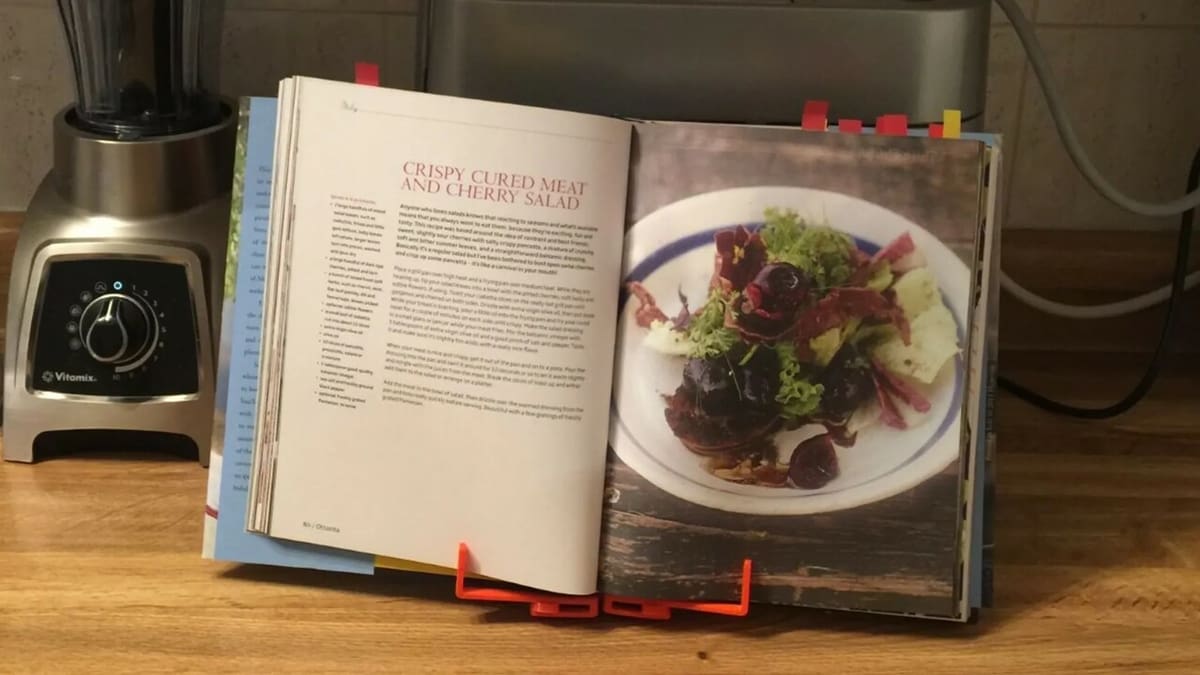
While cooking, it can be annoying when the pages of your recipe book turn or when it closes while you need to see the next set of instructions and your hands are all messy.
To solve this, a 3D printed book holder is a fantastic gadget that holds your cookbooks upright while you whip up some amazing dishes. The holder completely opens the book and keeps the pages in place for easy viewing and reading. So put this gadget on your countertop and enjoy a hassle-free cooking experience!
- Who designed it? Cameron
- How popular/printable is it? This extremely useful gadget has 62 makes!
- Where to find it? Printables
Coffee Refillable Pod Tools
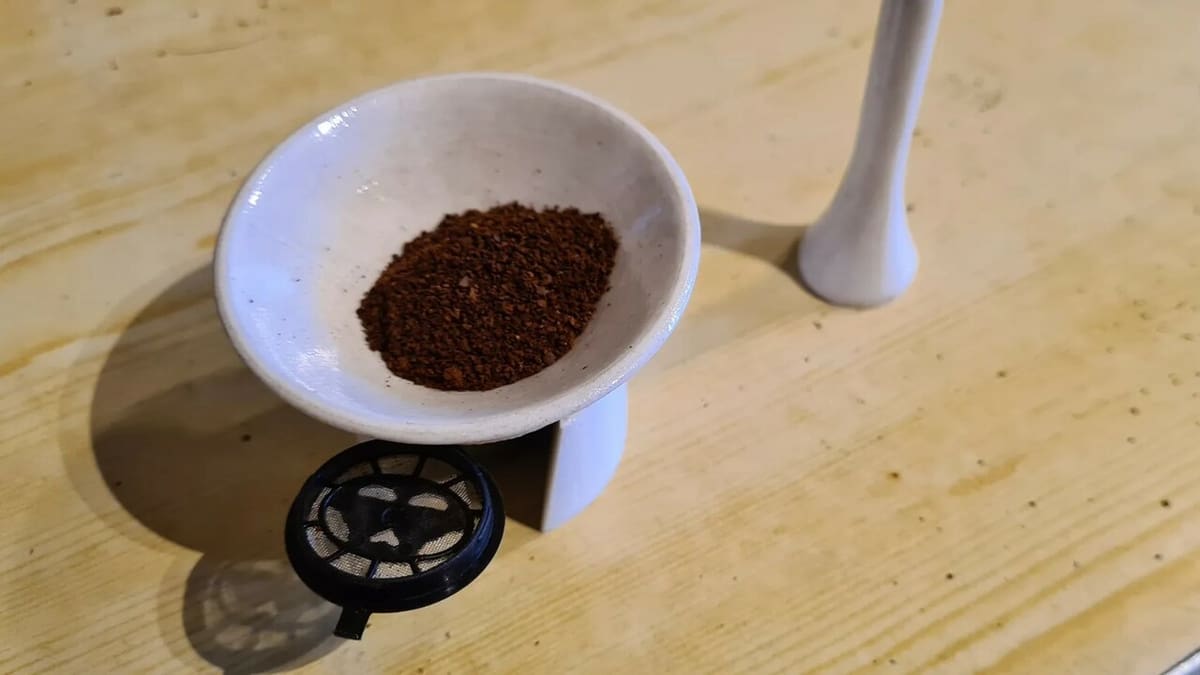
Okay, this isn’t so much for cooking as it is for preparing either a must for the morning or the perfect match for the slice of cake you’re having for dessert.
Everyone has their own recipe for the perfect cup of coffee, right? Since Nespresso machines started popping up everywhere, it’s even easier to quickly prepare something different and special with the push of a button – thanks to the emergence of reusable capsules, of course. This was great news for the environment and adventurers who prefer that special touch to savor every second.
Although capsule kits usually come with some tools, they may not be as practical. Some even come with a kind of brush to remove any excess on the edge to avoid disrupting the seal. This funnel is definitely mess-proof because, before you’ve had your coffee, sleepiness can disrupt the setup and cause some powdered art on the countertop.
With just 42 g of filament and layers at 0.2-mm height, you can have one ready in less than four and a half hours.
- Who designed it? AdamBrown
- How popular/printable is it? 4 makes and more than 160 downloads show that it can be a good idea that makers appreciate.
- Where to find it? Printables
Utensils
In this section, we’ve included models that are utensils or utensil-related, such as a cutlery kit card, a knife sheath, and chopsticks helpers!
Cutlery Card
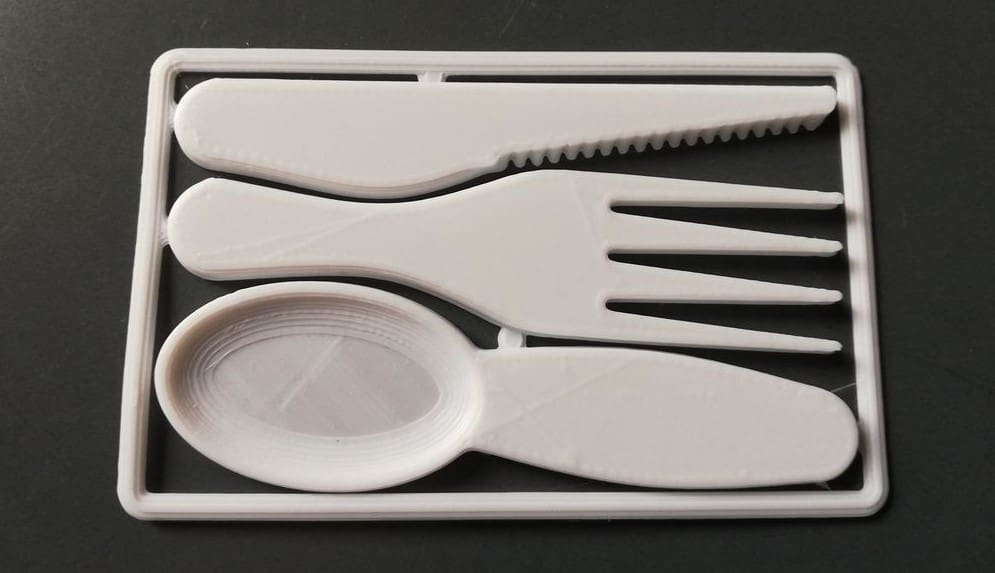
Do you ever wish you had some cutlery when you’re out and about? Well, you can quickly print this small cutlery card and keep one in your bag or wallet! To use it, simply pop the spoon, fork, and knife out of the card, and you’ll be ready for a meal.
As the model is only 3 mm thick, you may want to use a smaller layer height. The designer recommends either PLA or PET, though PETG is also a good candidate.
- Who designed it? UserBin
- How popular/printable is it? This handy cutlery card has a remix and over 8,000 downloads.
- Where to find it? Thingiverse
Knife Sharpening Aid
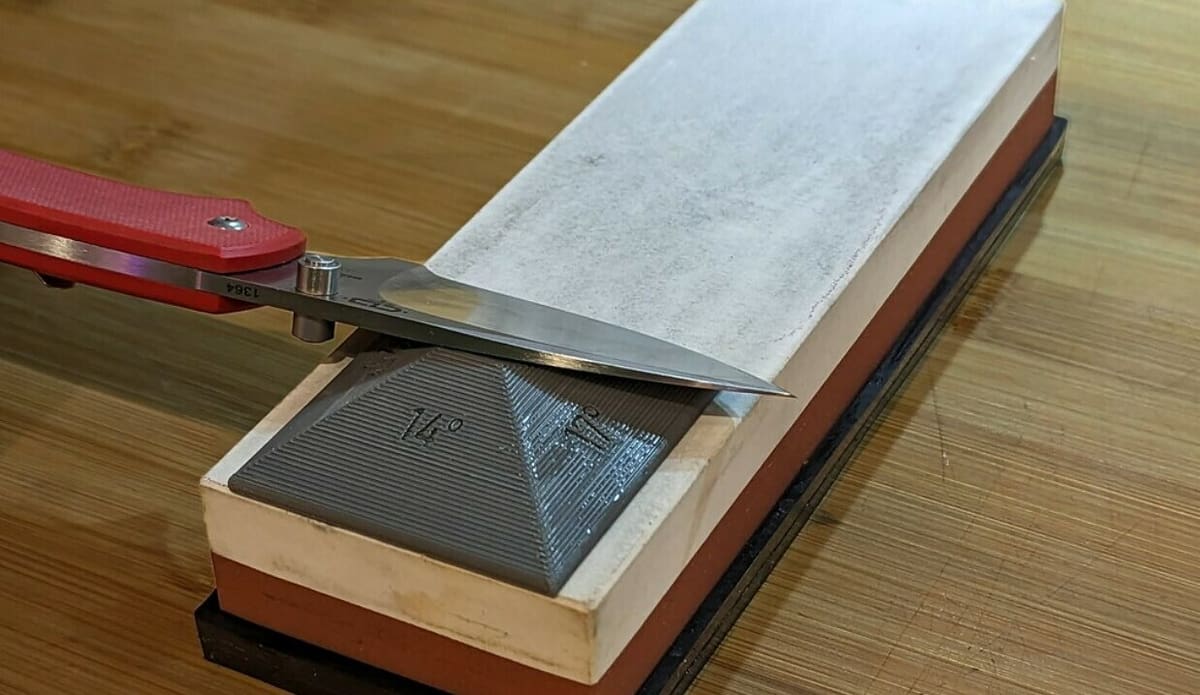
A knife sharpener is a handy tool in the kitchen that promotes safety, as dull knives can be dangerous. Knife sharpening is all about the angles, and this model will be a big help. It has various surfaces with inclined slopes.
Choose the right angle for your knife, place the model on the whetstone with the correct angle facing the length of the stone, then maintain the angle as you move your knife across the stone. Please keep in mind, though, that the sharpening aid is not intended to move with the blade.
- Who designed it? DevonRogers
- How popular/printable is it? This model is relatively new to Thingiverse, but with over 14,000 downloads, it’s gaining in popularity. Six makers have shared their prints, and there’s also a couple of remixes.
- Where to find it? Thingiverse
Customizable Sheath
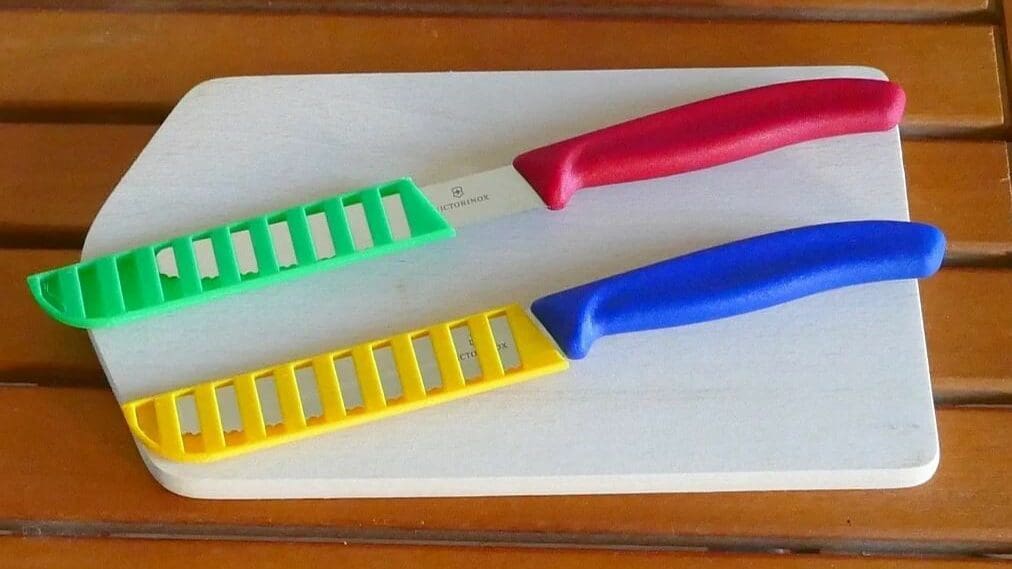
Protect your knives (and your hands) with a sheath, such as this clever parametric print. You can customize the model to fit your own knives by changing the dimensions or thickness of the sheath, as well as other settings for the gaps, like the angle or number. This design has gone through a few updates to improve the functionality and printability of the sheath.
The designer posted that they printed the model with a 10% infill, no raft, and no supports, but they recommend using a brim if bed adhesion is a problem on your printer.
- Who designed it? Bikecyclist
- How popular/printable is it? This design has over 147 remixes, and 8 makes have been shared.
- Where to find it? Thingiverse
Chopsticks Helper
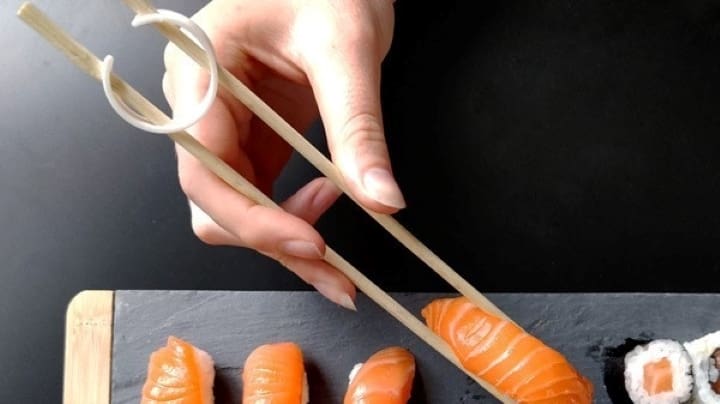
While chopsticks can be challenging for beginners to use effectively, this model makes regular chopsticks easier to handle. All you have to do is put the chopsticks through the printed part, and voilà, they’ll be held in place and should be much easier to use. The part should have a little flex or give to it, allowing it to bend a bit for the chopsticks to move.
The designer states that they printed the model in PLA with a 0.2-mm layer height, and one other maker shared that they used an infill of 17%. It should be a very quick and easy print.
Two-Fork Tongs
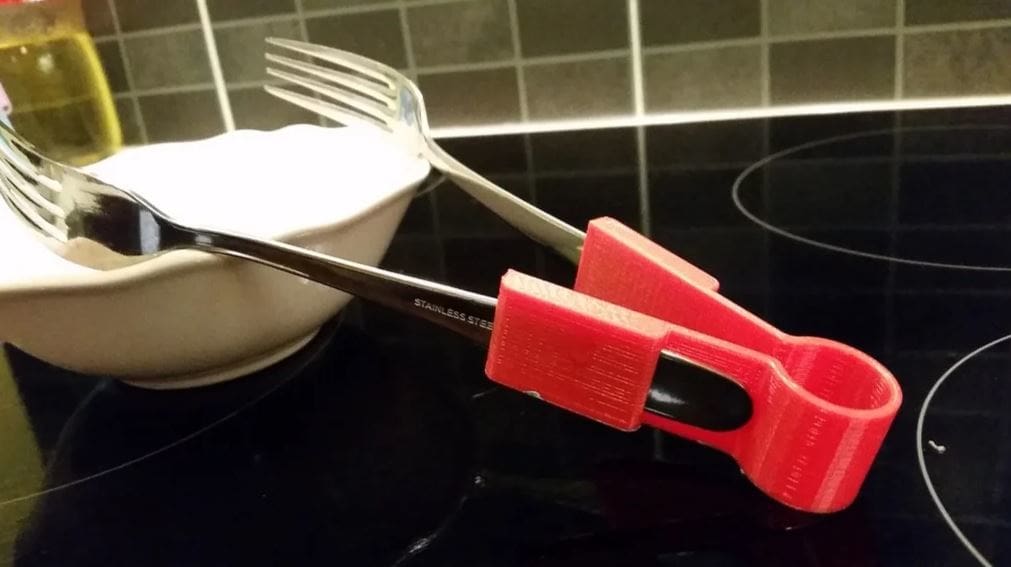
If you don’t have tongs for your grill or barbeque, don’t worry, this design allows you to turn two forks into makeshift tongs. Similar to the DIY chopsticks model, these tongs rely on moderate flexibility to allow the forks to press together and spring back when no pressure is applied. This model was designed in GeoMagic and fits forks with a 16.7-mm width and 2.2-mm thickness.
Due to the flexibility the part requires, the designer states that you need to print this kitchen accessory in ABS because of its flexural strength. They also listed that they used a 100% infill and a 0.3-mm layer height.
- Who designed it? vr50bt
- How popular/printable is it? This utensil design has 3 recorded makes, 2 remixes, and over 11,400 downloads!
- Where to find it? Thingiverse
At the Table
Whether you’re hosting a dinner party or enjoying a snack or solo meal at home, the following are great to have on hand.
Sunflower Coaster

This beautiful model will save your tabletops from watermark rings. Not only that, it’s flexible and fun to play with.
The designer suggests a concentric infill for the top layer. If you want a larger or smaller coaster, they recommend the scaling features in your slicer software.
- Who designed it? rorys3D
- How popular/printable is it? This model has over 505 shared makes.
- Where to find it? Printables
Capybara
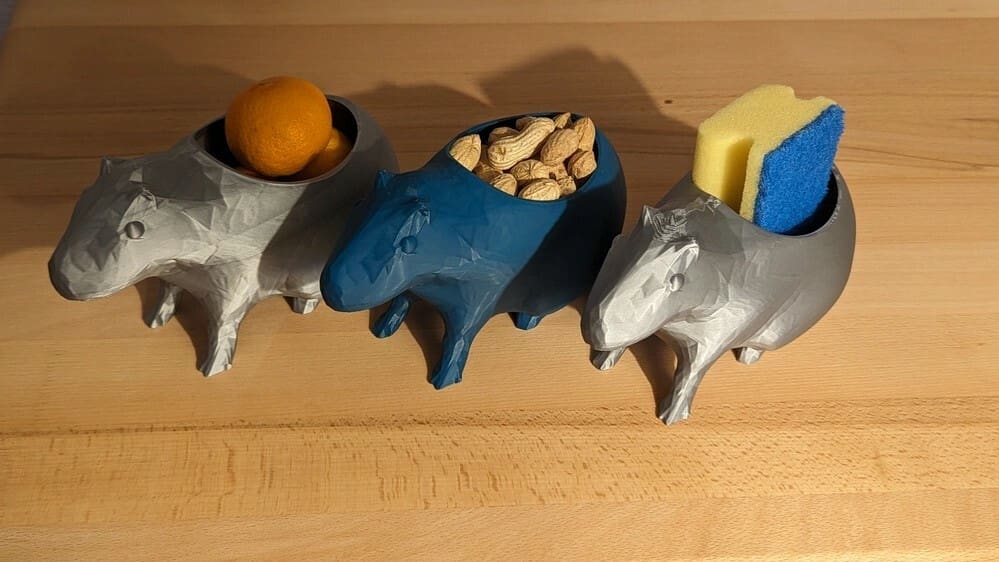
Keeping everything organized is important, but keeping everything organized and fun is even better! This mammal is becoming increasingly popular and the model can be used for utensils, as well as for other purposes – even as a plant pot to decorate the kitchen! Versatility is enhanced with additional parts like a lid, cutlery cover, or an organizer lid with holes.
To make this cute helper, the author recommends a layer height of 0.2 mm and three outer walls for all pieces; for the additional parts, the infill should increase from 10% to 15%. In the comments, you can see makes with beautiful filaments and even ideas for using it in other parts of the house. Either way, it’s a little pot with plenty of space.
- Who designed it? Blubdiwub
- How popular/printable is it? 104 makes show that the population of these mammals is increasing rapidly.
- Where to find it? MakerWorld
Fruit Stand

This fruit stand provides a stylish and functional place to store your fruit. The design is remixed from a CNC model, so you can make it with a mill or laser cutter.
The designer listed that they used a 20% infill to print this model in PLA. Based on the fruit stand’s size, it may take a lot of filament to print, and there are 12 different files to print to form the bowl shape. To mix it up, print the pieces in different colors to make a pattern!
- Who designed it? 3DGurgi
- How popular/printable is it? This fruit bowl design has 4 makes and over 1,000 downloads.
- Where to find it? Thingiverse
Banana Hanger
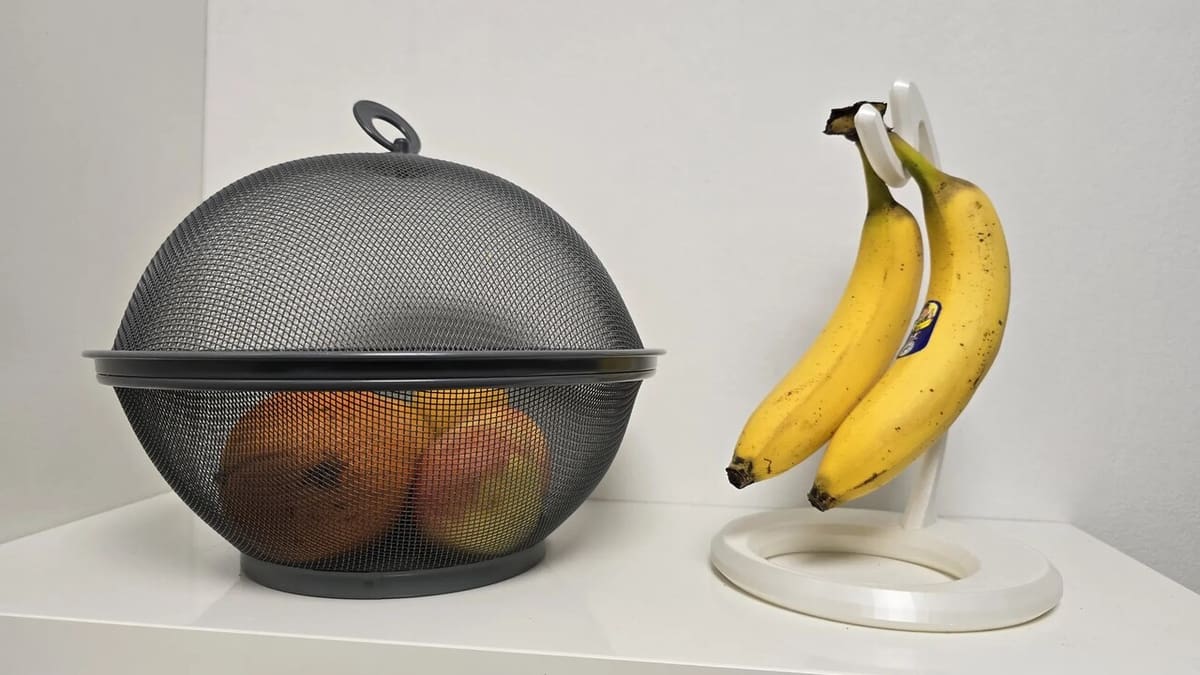
Bananas are one of the most popular and favorite fruits for any meal of the day, but putting them in a basket takes up a lot of space and can crush other more fragile goodies. This hanger not only frees up space in the basket, it also keeps the fruit in an easy-to-grab position – and it helps to decorate the room. You can explore the fruit’s colors with vibrant filament hues and give it a special touch!
The author points out that no glue, screws, or tools are needed to assemble this, so you can just slice and print. That said, in the comments some makers suggest using supports for the rod protrusion, if you want a better finish. Printing takes around 1.6 to 3 hours, and a layer height of 0.2 mm, 10% infill is, and 2 outer walls are recommended.
- Who designed it? Studio 727
- How popular/printable is it? With 1,400 downloads and 1,800 prints according to MakerWorld, it looks like this hanger is getting as popular as the fruit itself!
- Where to find it? MakerWorld
Balancing Wine Holder
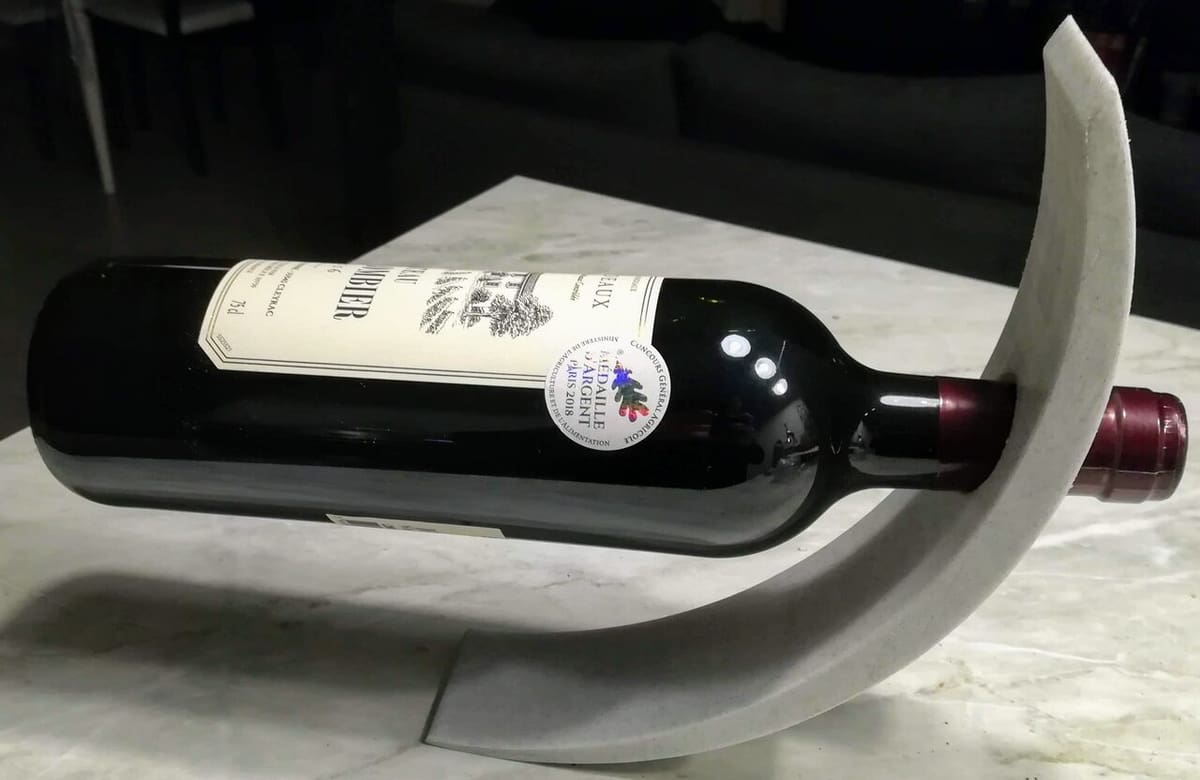
See, swirl, sniff, sip, savor, and balance? This next print will remove that last step so you can return to the five S’s of wine tasting. Deceptively simplistic but dazzlingly effective, this curved balancing wine holder will make you look twice.
Contrary to common belief, you don’t need magic to assemble this holder. In fact, it requires no assembly at all. Thanks to physics and a trusty 3D printer, you will be balancing your wine in no time. Makers suggest printing with at least 20% infill.
- Who designed it? thehalfnerd
- How popular/printable is it? If you don’t believe your eyes at first, check out the 24 makes on Thingiverse that prove that this holder actually works! In addition to the makes, there are five remixes.
- Where to find it? Thingiverse
Wine Bottle Holder
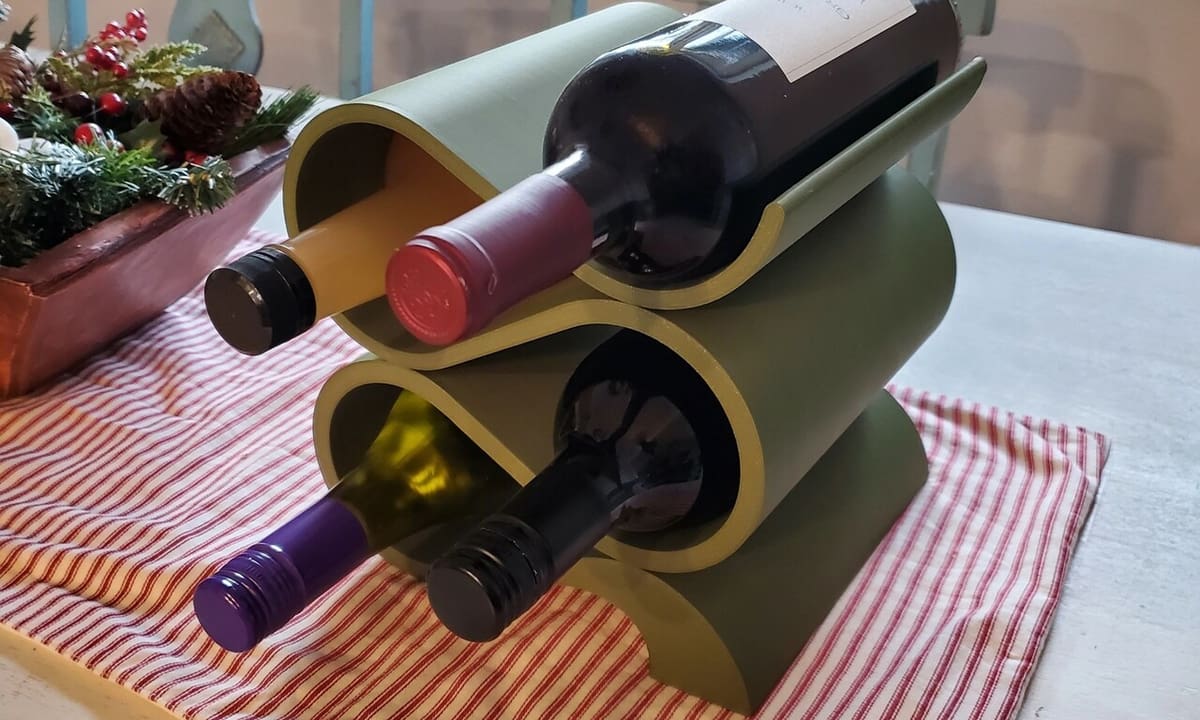
This model might be perfect for wine enthusiasts who want to have more than one bottle in display to match the right wine with the particular dish and occasion. This modern and elegant accessory will transform any corner into a small, tasteful wine cellar, pleasing to the eye as it is. With capacity for up to four bottles, it’s possible to have a good variety always at hand and well-organized without taking up much space in a timeless style.
The author guarantees that the design is strong and stable enough to ensure the safety of the bottles without them swinging or toppling over. There are two different versions: the first with 8% infill and two outer layer walls, and the second version is made to be more resistant with 20% infill and three outer layer walls.
- Who designed it? EngGraph
- How popular/printable is it? An amazing 482 makes and over 1,700 downloads make it clear how popular it is!
- Where to find it? MakerWorld
Bags, Jars, & Bottles
In this section, we’ve got some great models relating to your containers, including a bottle opener, can opener, and more!
Universal Bottle Opener
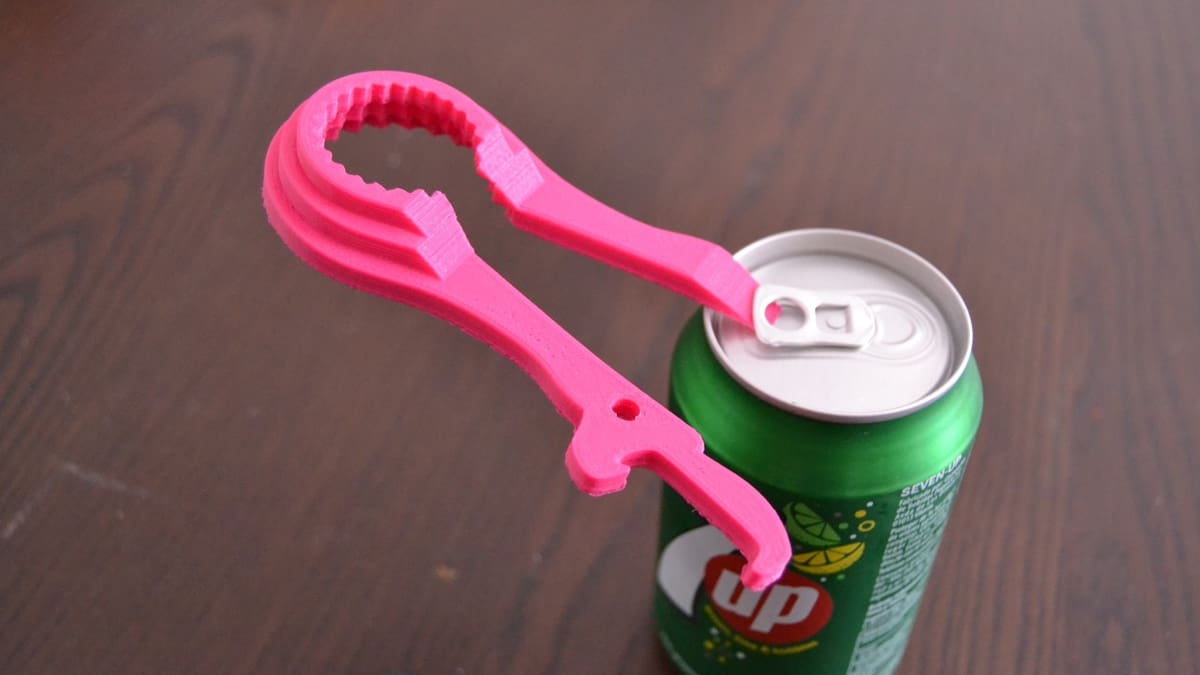
The Universal Bottle Opener (UBO) is an ingenious 3D printable part that makes it easy to open a wide range of bottles and cans. The UBO was actually designed to help elderly people and those with strength problems to easily open any drink, but even the strongest person sometimes needs help with a tricky lid!
The designer suggests a high resolution and high infill percentage (between 60% and 100%) to ensure the strength of this model. They also mentioned that they printed the model in PLA with supports activated.
- Who designed it? In3Designs
- How popular/printable is it? The UBO design has 106 recorded makes and 10 remixes. Many others have printed this model and so can you.
- Where to find it? Thingiverse
Jar Opener
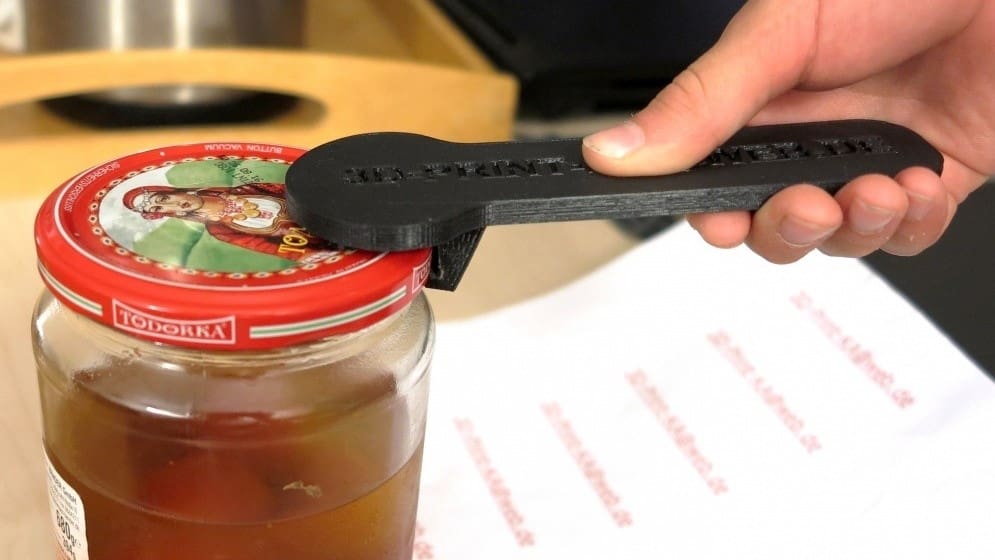
Ever needed to open a jar, but the lid wouldn’t budge? This 3D printable jar opener acts as a lever to release the seal of the jar, which should make the lid easy to unscrew.
Similar to the bottle opener, you’ll want to use a high infill percentage for strength; the designer suggests 70%. One commenter pointed out that the designer’s logo on the design is detailed and can be a challenge to print.
- Who designed it? 3D-Print-Ka
- How popular/printable is it? This jar opener design has over 13,600 views and over 1,900 downloads!
- Where to find it? MyMiniFactory
Bag Dispenser Clip
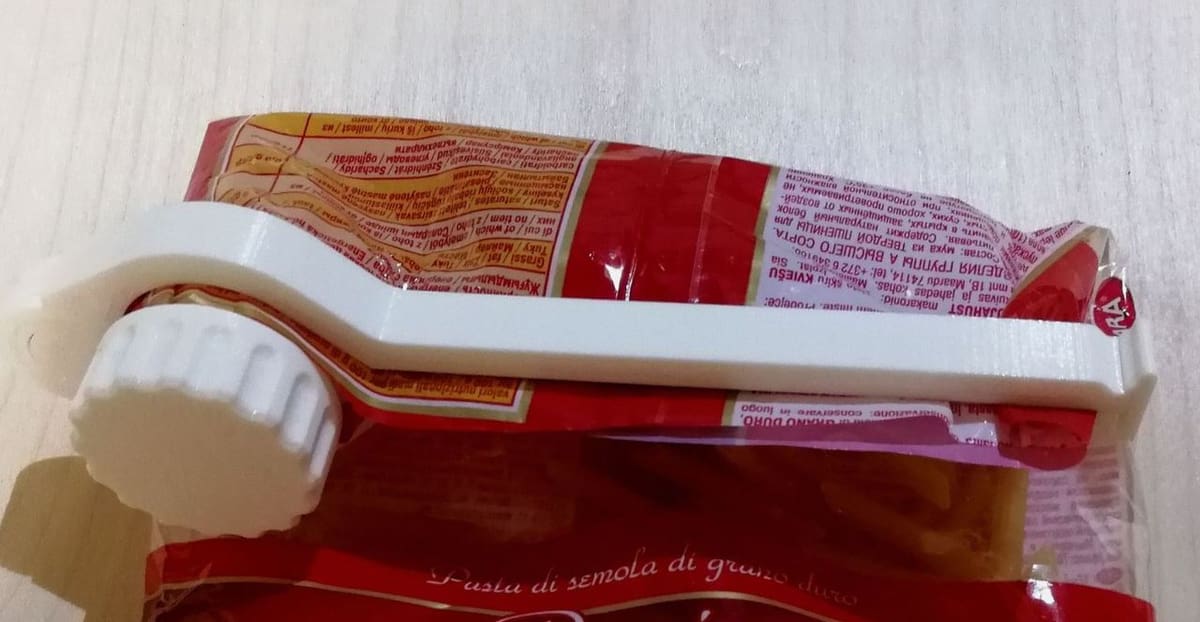
Leaving a bag of food unsealed can cause bread, chips, or other foods to get stale or hard. This contraption allows you to easily pour ingredients from a bag without removing the clip, keeping your snack fresh for longer while still accessible.
The design uses a print-in-place, two-part mechanism and two other parts (screw and cap). According to the designer, this model prints without supports, and you won’t need any additional hardware to put it together or use.
- Who designed it? WildVal
- How popular/printable is it? This screw-on dispensable bag clip has over 9,700 views and over 2,000 downloads.
- Where to find it? MyMiniFactory
Mason Jar Dispenser
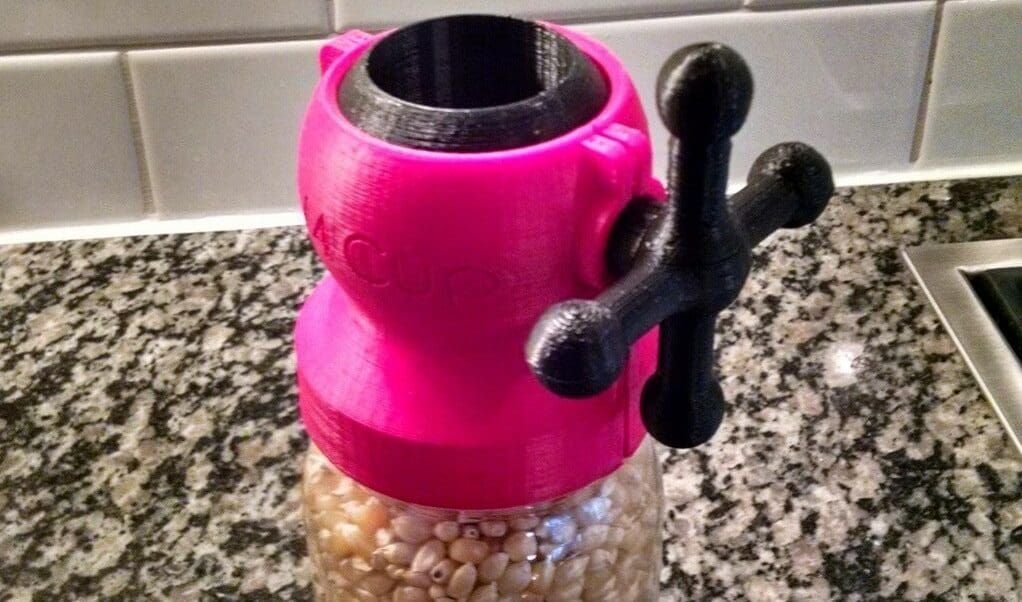
Mason jars add a rustic aesthetic to any kitchen, but they can be tough to dispense goods from. This mechanism allows you to quickly and easily dispense the contents of a Mason jar using a three-part system with a hand knob. All you have to do is add the contraption to a Mason jar, turn it upside down, and turn the wheel to start dispensing.
The designer states that they printed the model in ABS and glued the pieces of the mechanism together for a good fit. The creator also mentioned that they used M3 hardware (screws) to secure the contraption together.
- Who designed it? Stefan
- How popular/printable is it? This Mason jar dispenser has 2 recorded makes, 1 remix, and more than 6,000 downloads!
- Where to find it? Thingiverse
Cleaning
Upon hearing the word “kitchen”, many of us think first of food. However, some dread the cleaning. In this section, we’ve gathered some models that’ll hopefully make kitchen duty less dreadful.
Sponge Hammock
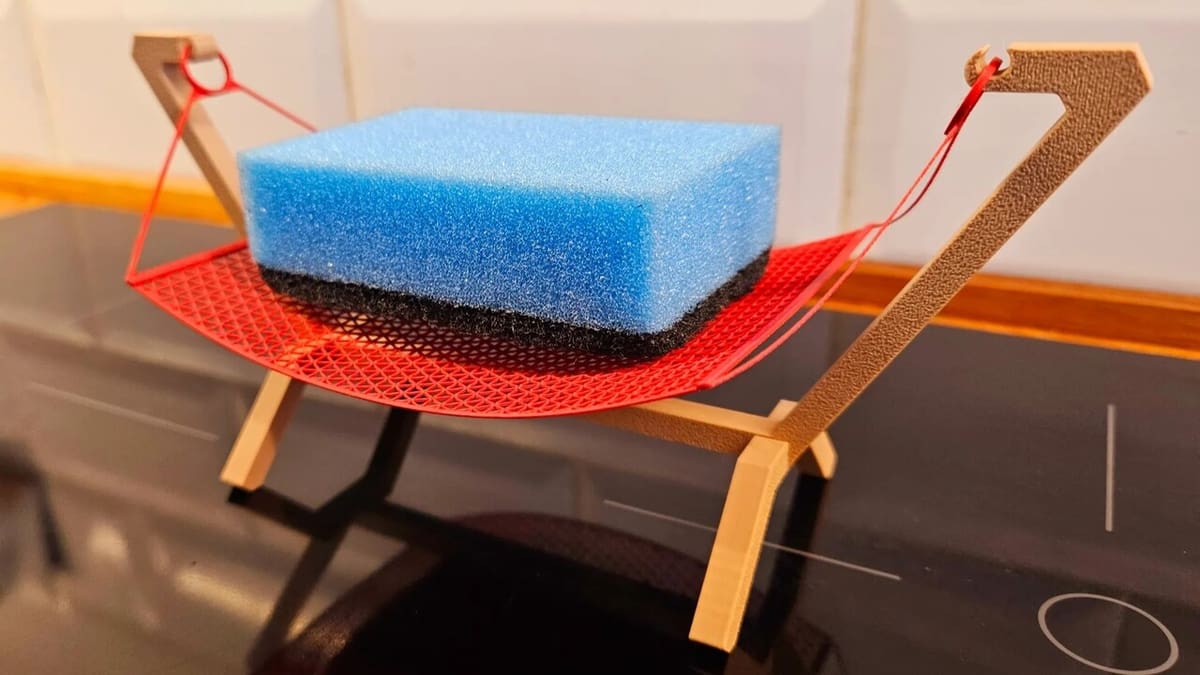
If the traditional sight of square plastic boxes for sponges gives you chills, this could be a great alternative to relax and make the environment more interesting. Well, maybe it’s not so relaxing for you, after all, this corner might just be the beginning of cleaning, but surely your sponge friend deserves a break after being drowned and scrubbed for a noble cause!
The designer has provided a total of 4 different versions of the model. The first is a version prepared for the AMS module from Bambu Labs, which is ideal for multicolor prints in one go. The second is also a version to be made in two different colors; however, one piece at a time on single-extruder machines. The third is a full version with both pieces in the same color, and the fourth is a reinforced version with more external walls and infill.
- Who designed it? wojteq5
- How popular/printable is it? 320 makes are proof that you can relax and print it!
- Where to find it? MakerWorld
Elephant Cutlery Drainer
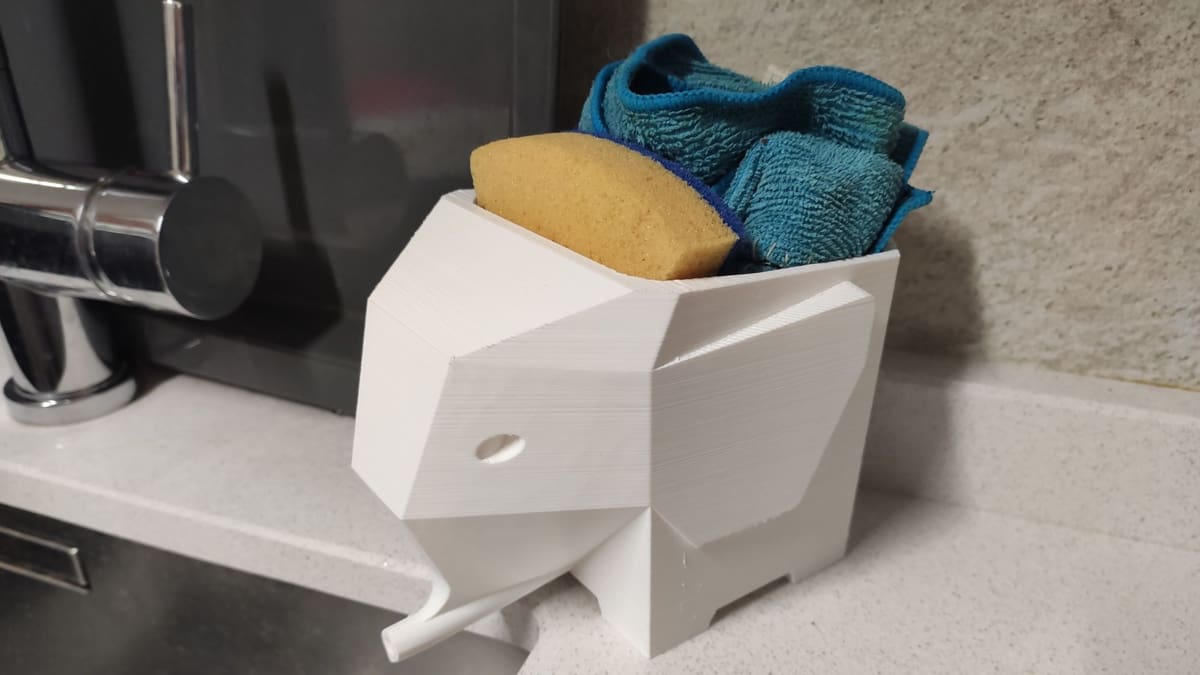
Prince Harry once noted, “People don’t realize how amazing elephants are.” And people definitely don’t realize how much their kitchen needs an adorable elephant drainer for spoons, forks, and the rest! All hyperbole aside, this 3D printed adorableness is a quick print and works well.
This model does require supports, but no other special print settings are necessary. Simply slice with your favorite printer profile, and you’ll have your own elephant drainer in just a few hours.
- Who designed it? aleiovanevcp
- How popular/printable is it? This model has 185 makes and 11 remixes! Some makers even used it as a small planter or sponge caddy (as seen in the image above).
- Where to find it? Thingiverse
Spray Holder
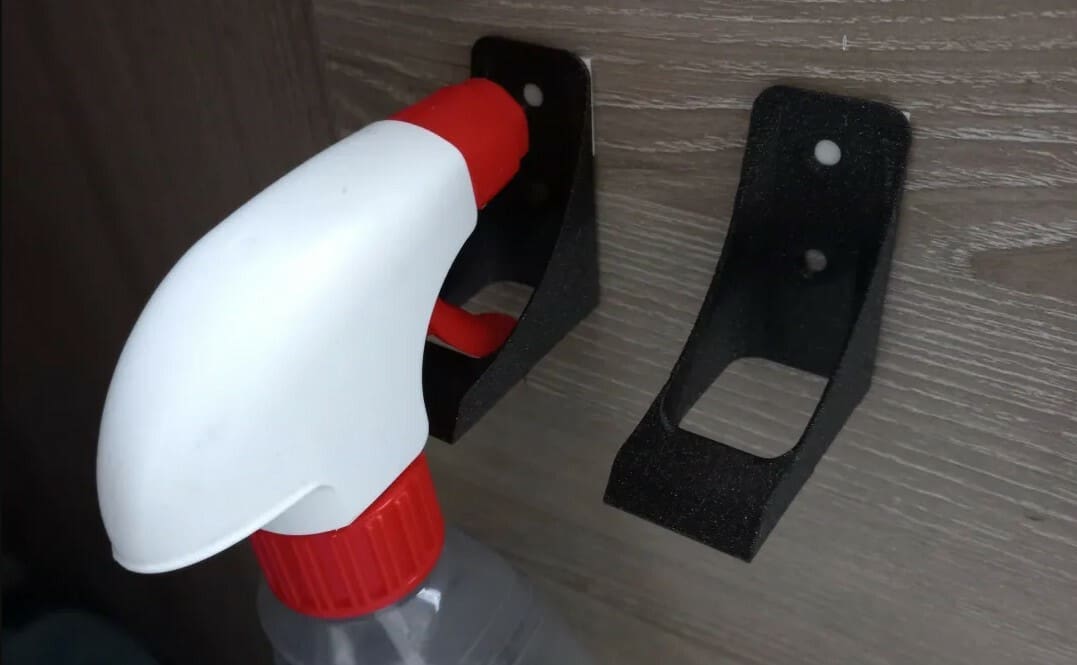
Having a clean kitchen is very important, and there’s probably a glut of cleaning products under your kitchen sink. With this model, you can create the perfect spot for your spray cleaners. It can be fixed to a wall or cabinet interior using adhesive or screws drilled into the wall.
If you want to customize the design to your favorite cleaning supplies, the designer included a CAD file that can be edited.
- Who designed it? Ellrico
- How popular/printable is it? This design has 115 makes as well as 9 remixes.
- Where to find it? Printables
Drying Rack
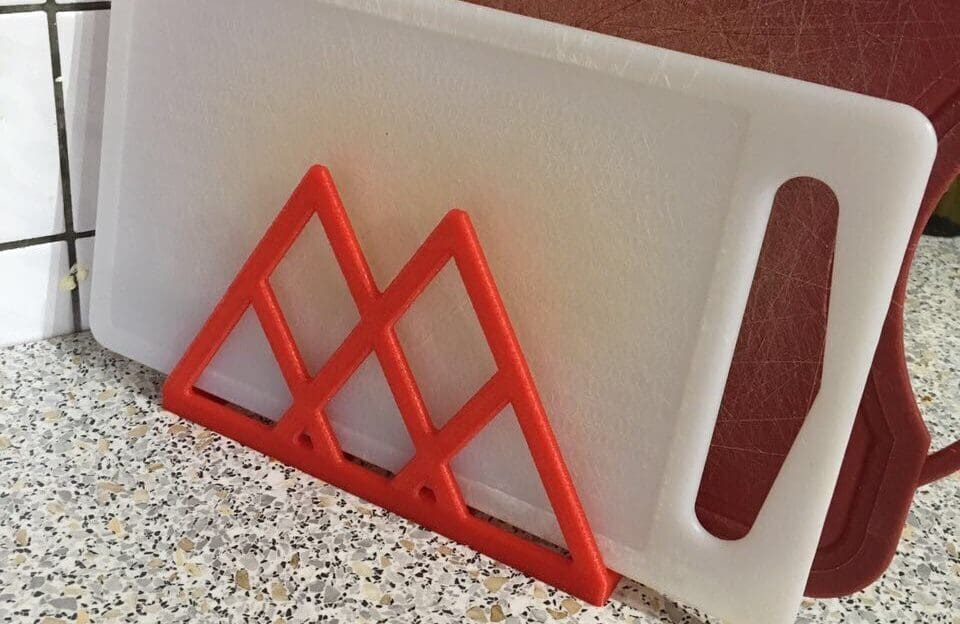
So, you’re doing the dishes. Where the heck do you put the big stuff to dry? This drying rack is perfect for platters, cutting boards, plates, and the like. The only caveat is that they can be no more than 20 mm thick. The remixes, however, offer more drying space as well as slightly thicker slots.
According to the designer, the model was designed to save on material while also staying robust to support heavy items. They suggest a 0.19-mm layer height and 20% infill.
- Who designed it? efliq
- How popular/printable is it? Eight makers have printed this useful design, and three others have remixed it to include more drying slots.
- Where to find it? Thingiverse
Gravity Broom Holder
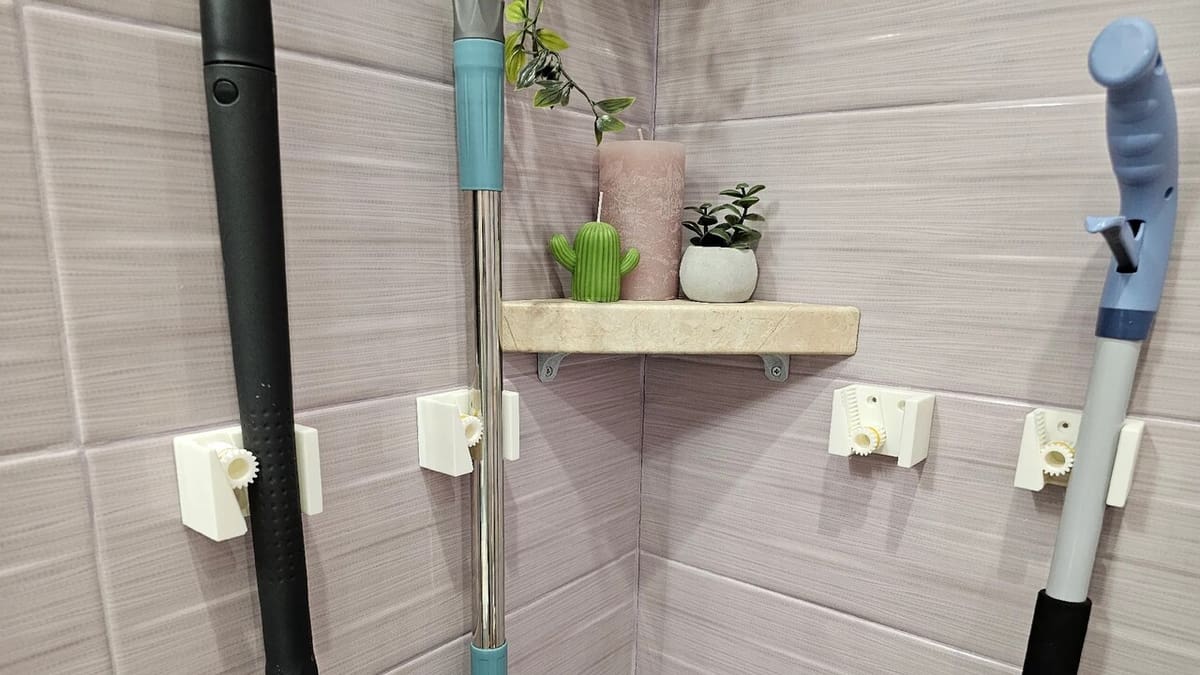
It’s amazing how many different cleaning tools you can find out there! If you’ve got a broomstick, dustpan, different mops, and a feather duster, you’ll find that the handles can be made of many different materials, and some of them don’t even have holes or proper support. Thinking about how to organize everything in one place with just one type of holder can seem like a challenge, but this design is perfect for the job. It uses a rolling gear and the item’s own weight to hold it in place, and you can simply remove it by lifting it while pulling it out.
The support accommodates handles with diameters of 21 mm to 28 mm, and the designer shared two versions: one that can be fixed with common drywall screws and another with customized drywall screws. The author indicates that for wooden handles, only 3D printing provides good adhesion, however for metal ones, it’s necessary to add a few turns of a small elastic band to the conical part of the gear. Standard PLA should do the trick, and no supports are needed.
- Who designed it? LoboCNC
- How popular/printable is it? An incredible 1,423 makes and 64,000 downloads make it clear that it’s not difficult to make your own!
- Where to find it? Printables
Storage & Organization
While you can have a lot of kitchen gear, you should always have a designated spot for all your essentials. This section features 3D printable storage and organization models to keep your kitchen tidy.
Tea Box
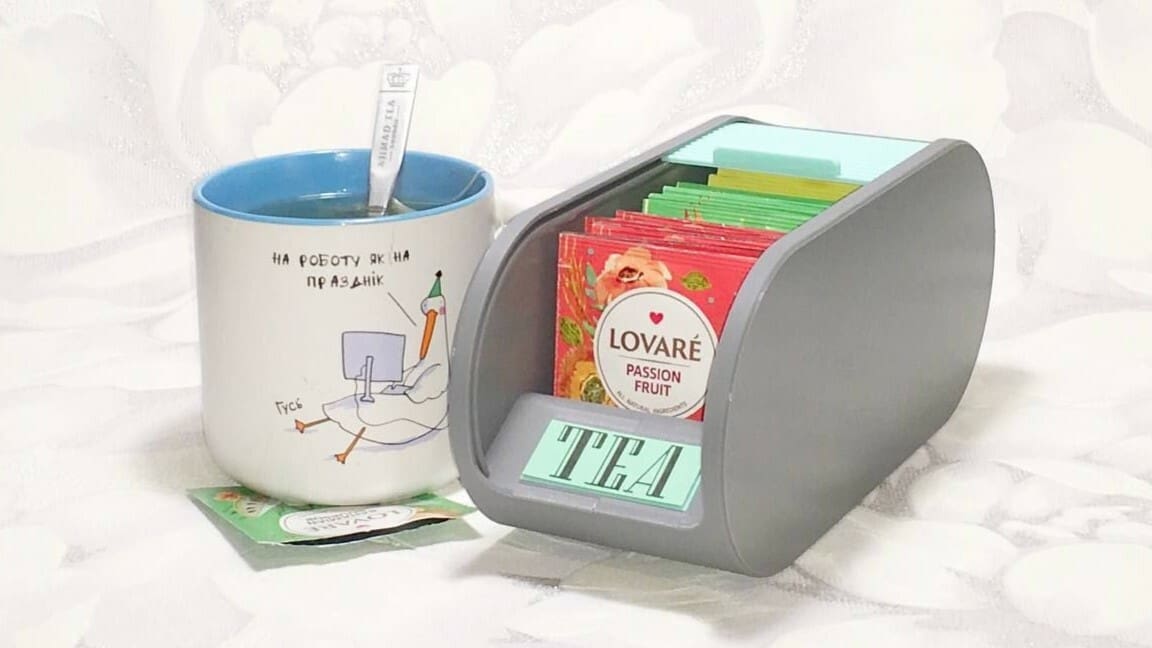
This design is a must for tea lovers. It includes a few parts that can be simply assembled using the provided guidelines.
All the parts are printable without any supports. You can adjust the size of the assembly with the help of scaling and careful placement. The design is quite flexible and various different sizing options are available. Check out this detailed video regarding the build.
- Who designed it? 3DPrinty
- How popular/printable is it? This dynamic model has 62 shared makes.
- Where to find it? Printables
Warrior Knife Block
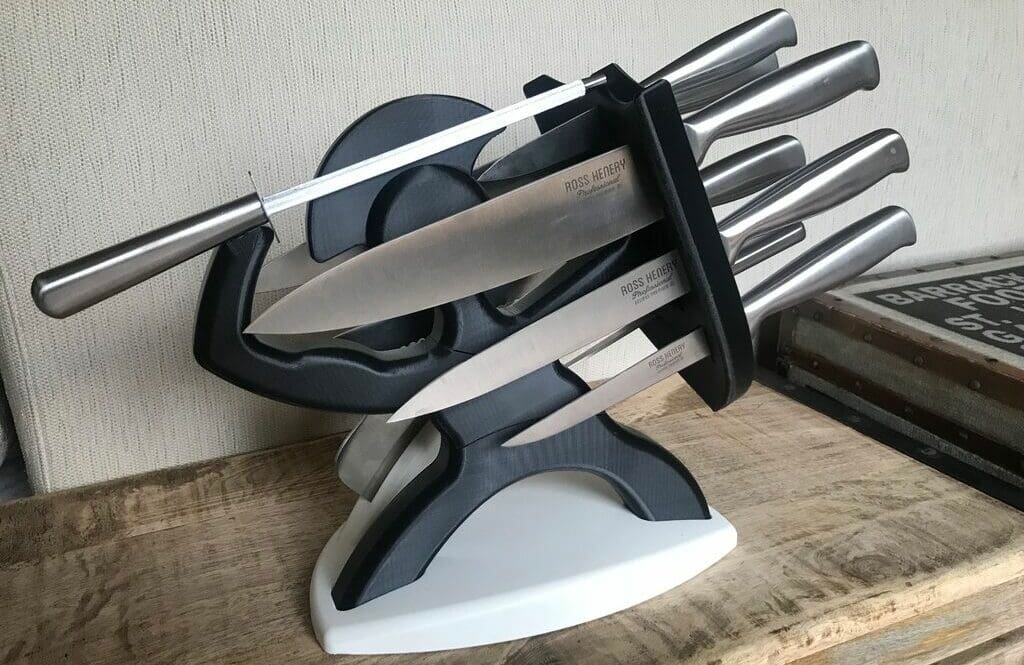
Every kitchen warrior eventually has to face the challenge of storing knives. This warrior knife block, based on a Snapmaker project, is up to that challenge. Designed specifically for this Ross Henery Professional knife set, this block has everything you need to store your kitchen knives safely, neatly, and stylishly!
A bottom weight or ballast of at least 2 kg will ensure your knife block doesn’t topple over. Also, be sure to secure knives in place with magnets. You can even print rubber feet to make sure the block doesn’t slide around your countertop.
- Who designed it? Nonsolo3D
- How popular/printable is it? Four makes, as well as a remix, have been posted on Thingiverse so far. The results are epic, especially the three-color print!
- Where to find it? Thingiverse
Utensil Basket
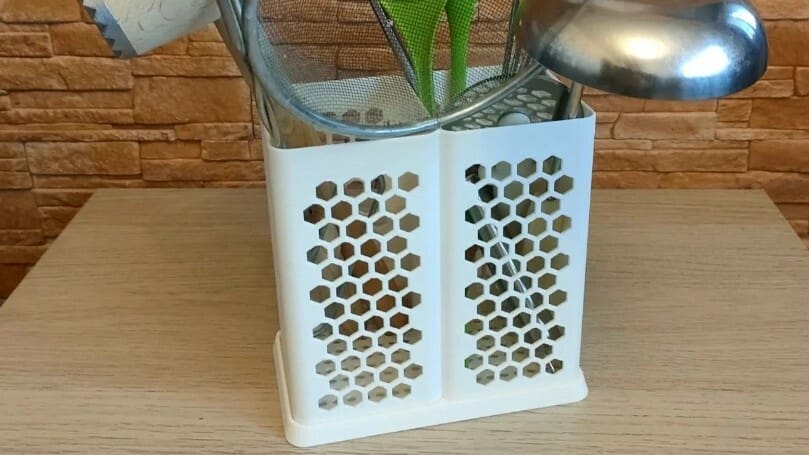
Having your utensils at hand is important to streamline the hustle and bustle of daily life, and a small basket at the kitchen table is a great organizing option. This model is fully perforated, even at the bottom, to prevent liquid buildup, but there is also a base to prevent spills. The honeycomb shape brings an elegant and modern design that can easily complement the environment in case you want to have it at the dining table instead of the kitchen.
The parts can be printed separately without any difficulty because supports aren’t necessary, and a layer height of 0.3 mm or less is recommended. Go ahead and try this basket in vibrant colors or in the one that best matches your kitchen, whether for drying or keeping it at hand – it will be a tasteful choice!
- Who designed it? DGA3DP
- How popular/printable is it? 138 makes speak for the model’s popularity, and you can be the first to share a beautiful colorful version!
- Where to find it? MakerWorld
Cutlery Tray
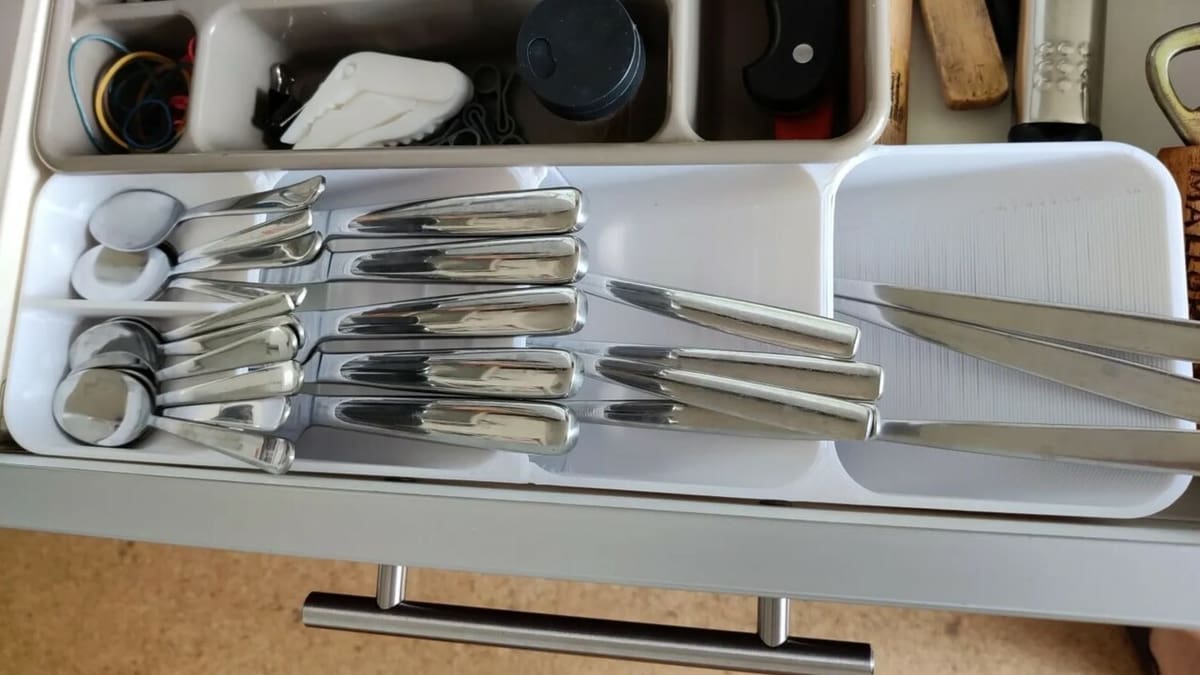
With so many items stored in kitchen drawers, clutter may be almost unavoidable, making it difficult to find what you need when you need it. A cutlery tray organizer that’s compact and minimal with a clean design is the perfect solution.
One thing to note is that your drawer should have a minimum depth of 9 cm. Depending on your printer bed size, the maker recommends printing it as a single tray or in two halves. If you print it in halves, you can easily fit the parts together (no bolts or nuts necessary), making your cutlery easily accessible.
- Who designed it? CuriousMint
- How popular/printable is it? This minimal tray has over 3,600 downloads and 25 makes.
- Where to find it? Printables
Utensil Hanger
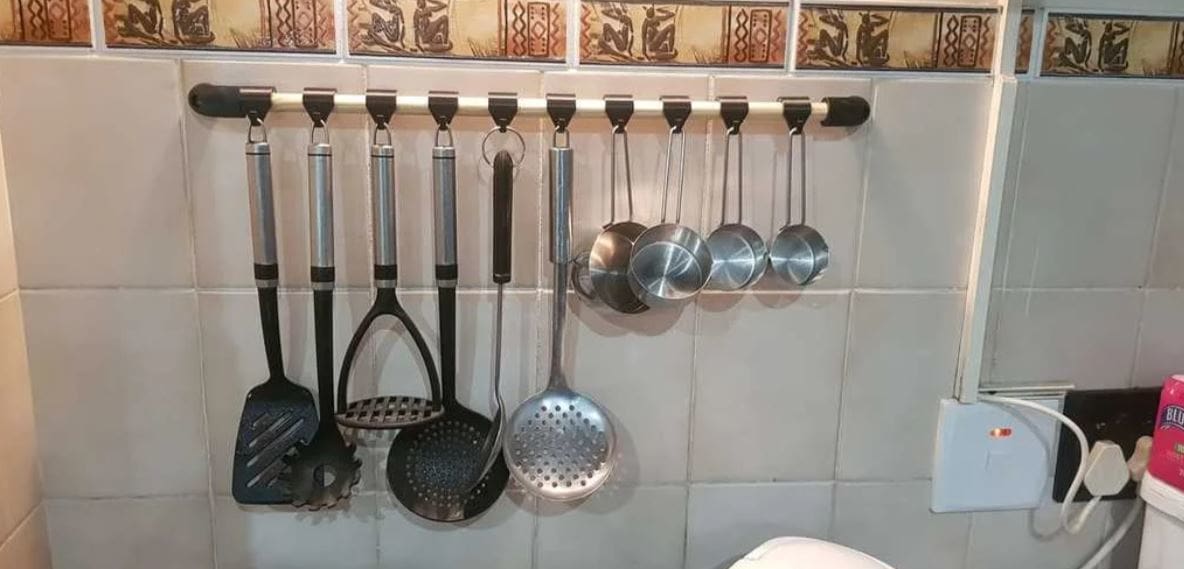
Larger utensils can be difficult to store, especially if you’ve run out of cabinets or drawer space. This simple utensil holder can grip onto a circular surface (like a pole) and provides hooks for hanging large utensils like spatulas or strainers. The designer suggests using a 5/8″ wooden pole to attach the hooks, but you should be able to scale the model up or down depending on what size you want to use.
The maker listed their print settings for this utensil hanger, including a 20% infill, no raft, and supports activated. They also stated that they printed the model in PLA.
- Who designed it? Volkvanmyn25
- How popular/printable is it? This kitchen utensil hanger model has 1 remix and over 400 downloads.
- Where to find it? Thingiverse
Bag Dispenser
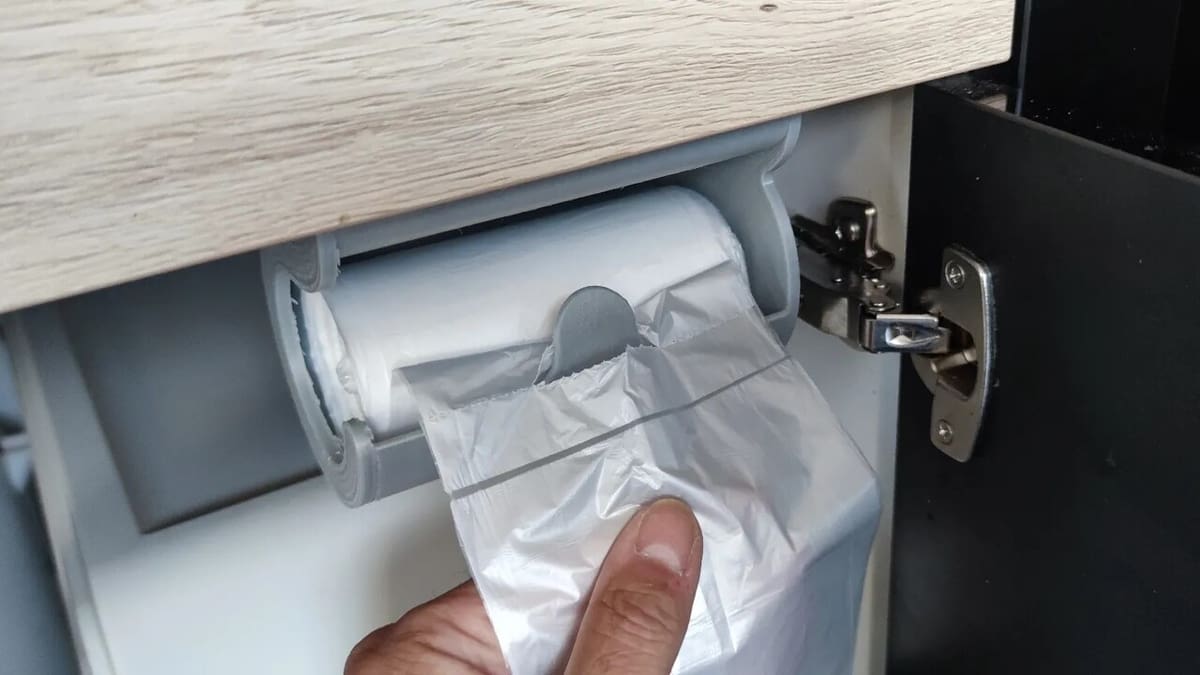
When it’s time to clean and tidy up, the challenges start to appear. Faced with a busy routine and little time to keep everything in order, it’s not hard to imagine how someone, in a rush, might drop a roll of trash bags and see it roll below a counter, bags unrolling all over, creating yet another mess. Well, now your 3D printer can solve this challenge and leave everything in the right place!
The dispenser is designed to be screwed to the underside of a counter, making it a discreet installation to a cabinet, cupboard, or to the underside of the kitchen counter. Two screws are required to fix it, and the printing guidelines recommend 0.2-mm layer height, 5 outer walls, and 25% infill. The complete print should take a little less than 5 hours.
- Who designed it? Axel Dreher
- How popular/printable is it? This recent model has around 20 downloads and 4 shared prints so far, according to MakerWorld.
- Where to find it? MakerWorld
Tupperware Lid Organizers
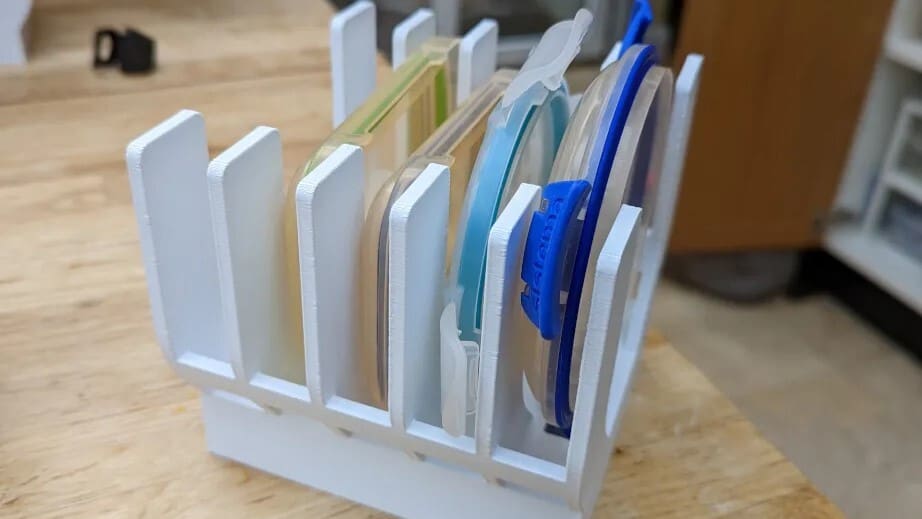
Over time, organizing your Tupperware – and the always misplaced lids – in a cupboard without making a mess can become a challenge. After all, the possibility of having containers and lids of all sizes and types everywhere is very real. This model not only eliminates the chaos of disorganized containers, but also adds a touch of modernity and practicality to any space.
To successfully reproduce this model, the maker recommends a 0.2-mm layer height, 4 walls, and 15% infill. User reviews highlight the need to balance material consumption and model robustness, with some recommending an infill higher than 20% for those seeking greater stability. However, the default settings already provide performance that should meet most needs well.
- Who designed it? HaughtyGrayAlien
- How popular/printable is it? With over 550 downloads and almost 300 prints according to MakerWorld, this is a popular model!
- Where to find it? MakerWorld
Toothpick Hedgehog
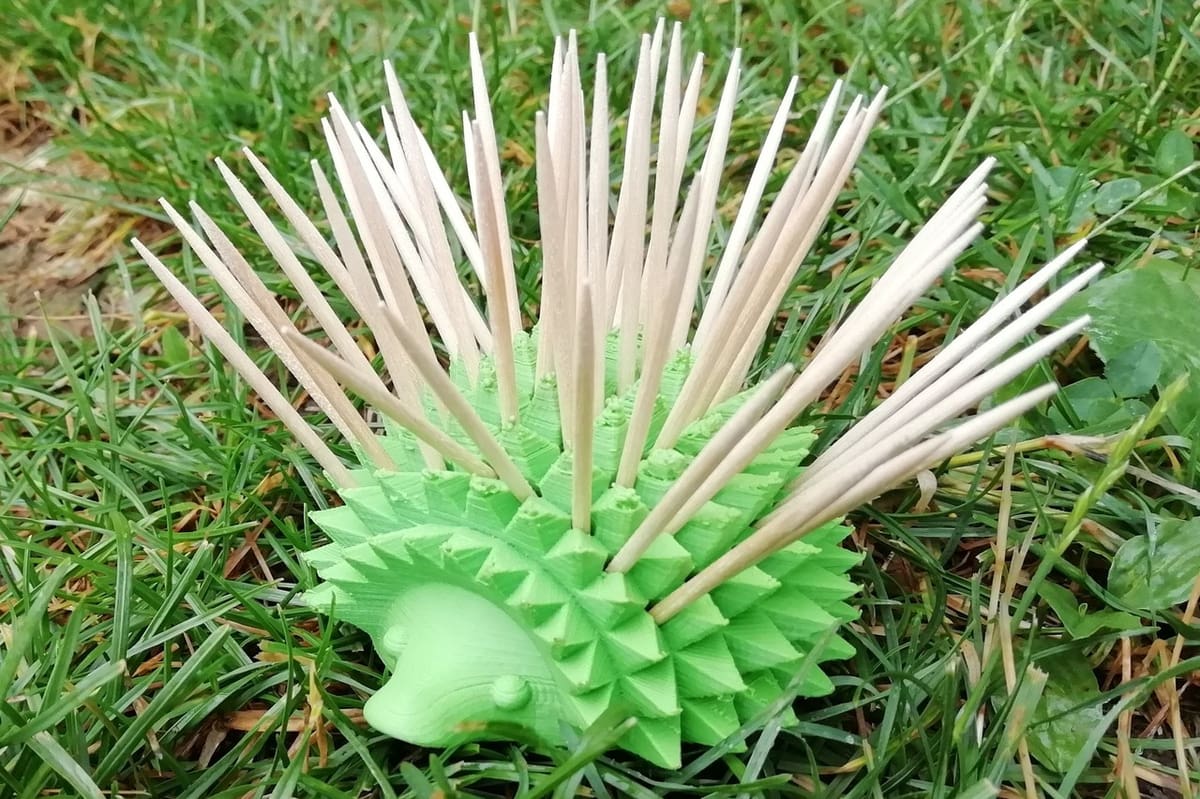
Toothpicks can be a tricky kitchen accessory to store as they’re small enough to lose but important enough to remember you definitely had some somewhere… This hedgehog design can store your toothpicks in pride of place. The hedgehog has a maximum capacity of 54 toothpicks.
The designer listed that the print took 10 hours and that they used supports. We recommend using a high resolution to ensure the spikes keep their detail.
- Who designed it? timothemarsot
- How popular/printable is it? This toothpick hedgehog has over 8,800 views and 550 downloads.
- Where to find it? Cults
Drink Dispenser
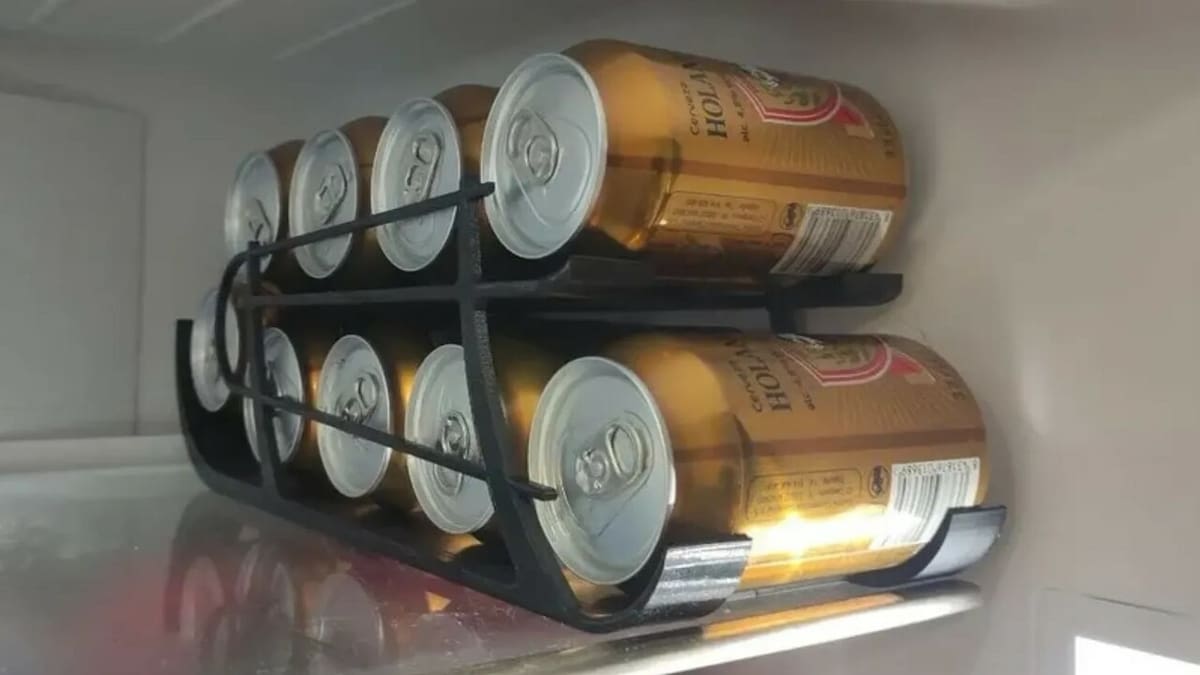
This compact drink dispenser lets you store your cans in the fridge and grab a cold one whenever you want! The original dispenser’s design allows you to stack up to nine cans (of a specific dimension) at once, freeing up more storage space.
Additionally, the maker has provided CAD files that you can use to modify the dispenser to fit your fridge space and hold your favorite drinks.
- Who designed it? LjhtomJavierHernando
- How popular/printable is it? 56 people have shared their successful makes of this model.
- Where to find it? Printables
Fridge Sticky Note Holder
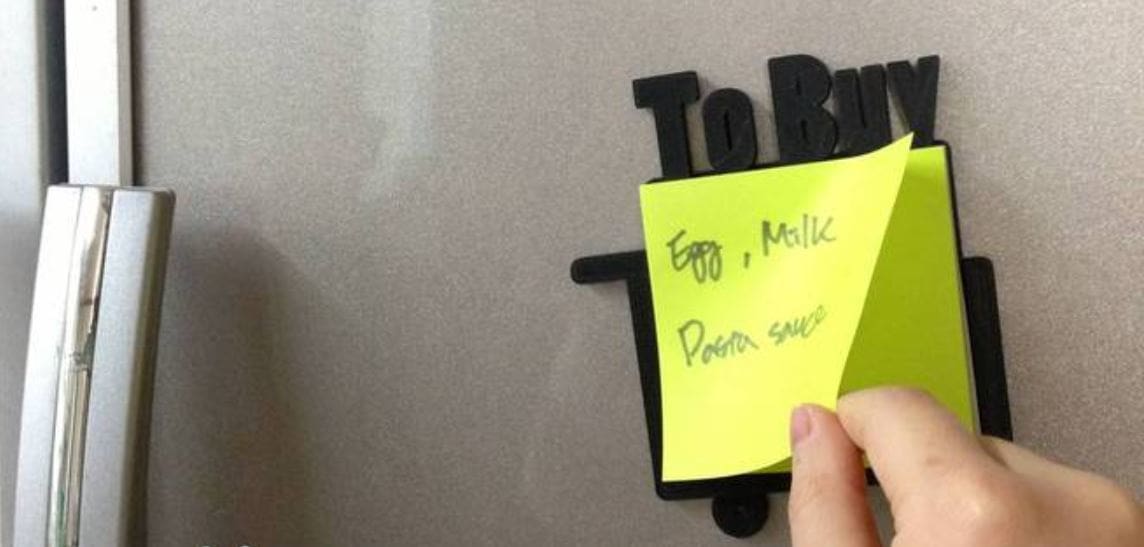
In many households, the fridge acts like a kitchen notice board, with magnets, reminders, and photos spread all over. This model is for holding sticky notes on your fridge so you can use them to remind others (or yourself) what you need to do, whether that’s a grocery list or a daily schedule.
The design prints in a single part and attaches to your fridge using a flat magnet glued to the back.
License: The text of "40 Cool 3D Printed Kitchen Gadgets" by All3DP is licensed under a Creative Commons Attribution 4.0 International License.

